#but i think a majority of my traffic is from me posting links on my social media when i sell something anyway so i dont
Text
People Think Krist Is Homophobic (but He Isn’t)
[TW: discussions of homophobia, death threats, "the rape filter joke", etc.]
Last September, I made a thread about The Whole Krist Thing, and I'd like to make a version here on Tumblr as well.

NOTE: My being a queer fan of Krist doesn’t override the feelings or opinions of other queer people. I fully understand that time on this planet is limited and you don't need to exert precious energy into researching an actor. The reason I'm making this is to provide context for people who are new to the fandom or just wondering why Krist is known as homophobic.
- Why I Made the Twitter Thread -
As a queer international fan living abroad, my understanding of Thailand, Thai culture, and Thai language is extremely limited. Like most of us, I rely entirely on translations, both official and fan-made.
After watching SOTUS for the first time in 2020, I saw English-speaking fans claiming that Krist Perawat, the actor who played Arthit, was homophobic. And it wasn't just one or two people saying it. It was dozens. Hundreds. That called for some research. I loved Arthit, and Krist's empathetic portrayal of him didn't mesh with the angry guy in the Instagram photo I was seeing passed around.
I'd made a number of queer Peraya fans on Twitter, so I went to them individually and asked, "What's this about Krist being homophobic?" As queer fans who were knowledgable and openly fond of Krist, I wanted to hear their side of things.
They sent me links and photos and videos and translations that thoroughly explained how Krist's reputation for being homophobic had gotten so out of control. The problem: those things weren't compiled in one place, and they were all on Twitter where the Asian Peraya fandom is most active. Interfans, meanwhile, took the worst of everything they could find and compiled it into contextless videos for Instagram, YouTube, TikTok, etc. Since the vast majority of Krist's fanbase is spread across Asia and many of them don't engage with the international fandom, it's no wonder to me that the homophobia thing has become so ubiquitous over the years.
It's a paradox where, in order to see the evidence of Krist's allyship, you kind of have to be a fan already. Or you have to know which keywords to use to navigate Twitter's nightmare of a search function (I know, Tumblr is worse). While I made that thread, I was regularly texting Peraya I knew things like, "Do you know where that one interview from 2019 is?" or, "Did you take a screenshot of the marriage equality post he made last month?"
The thread was difficult to make, and I'm a fan! What I know of Krist, I know because I've been a fan for three years and I have access to information that fans who have been here much longer can find.
I also procrastinated on making it for ages. I knew the amount of vitriol people hold against him, and I just wanted to enjoy my time in fandom quietly without calling waves of anger and hate to my carefully curated little corner of sunshine.
Then Krist was in a car accident.
And even though he was reportedly driving safely and slowly, Thailand is notorious for its poorly maintained roads and a high number of traffic accidents. Only months after receiving his first driver's license, Krist's car flipped upside down, and he had to reassure fans from the hospital that he was physically all right, just shaken.
Meanwhile, some international fans thought it was funny.

And that's when I started making the thread.
So, with all that said, let's start with Krist's allyship, because I know most of us agree that that's the bare minimum for an actor working in the BL industry and profiting off the queer community.
- Acts of Allyship -
In the early days of their SOTUS fame, Krist and Singto were interviewed about the LGBTQ+ community.
Acceptance and equality is something that the LGBTQ community still struggles to achieve up to this day. But both Singto and Krist believe that this should not be the case. “They are just humans. They are like me, and they are like everyone,” Krist claims. Furthermore, he mentions that we should all be given the freedom to love anyone we want to love. “It’s just natural,” he says.
“They don’t have to understand now,” Singto says, referring to those who can’t grasp same-sex relationships. “One day, when they find their true love, they will realize that love is the same no matter the gender.” Krist adds, “Gender is not relevant when it comes to love. But in case some people still don’t understand this in time, what’s important is that we all give due respect to each other at the end of the day.”
He's also educated himself in colors representative of the LGBTQ+ community.
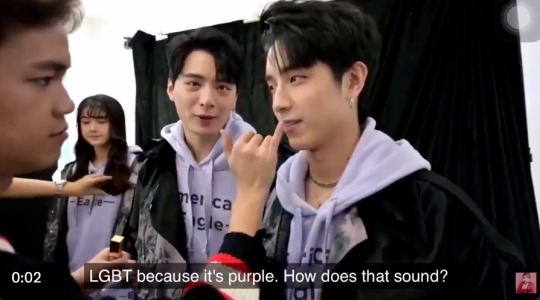
When Krist and Singto attended an award ceremony for their photoshoot in the gay magazine Attitude, Krist shared a sentiment that he gave to a queer friend of his. "If no one accepts you, you can stay with me, because I accept you for who you are." [Paraphrased]
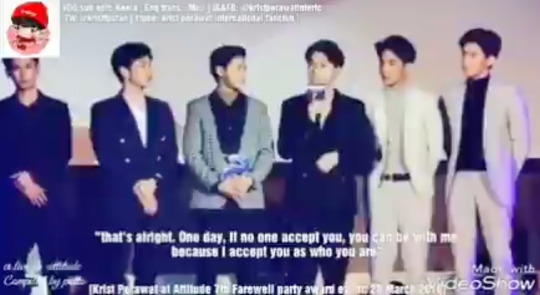
Despite Thailand's current government leaning on BL series as a new soft power, it's still very conservative, and its people are to this day fighting to see equal marriage recognized.
Krist often adds his voice to this fight on Instagram, specifically as someone who works in the BL industry. These were in 2021 and 2022:

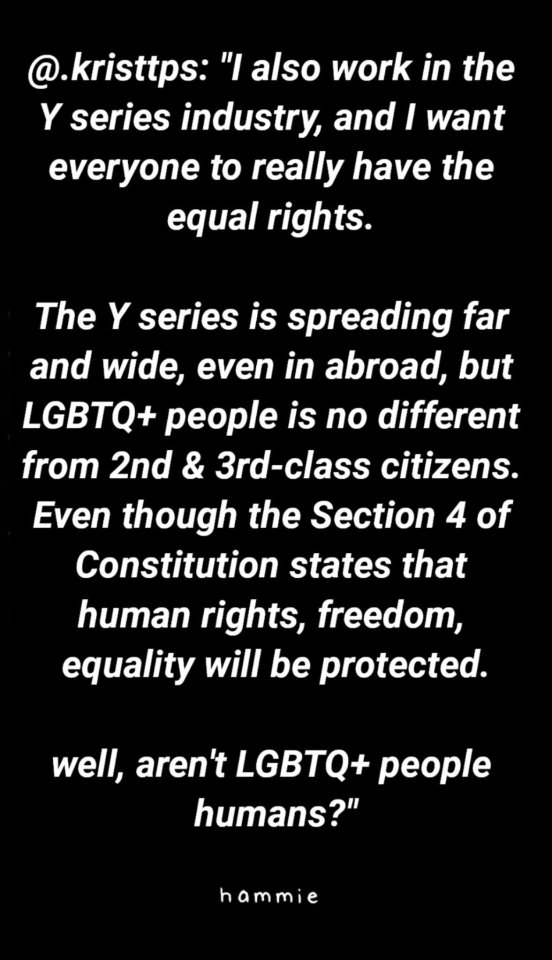
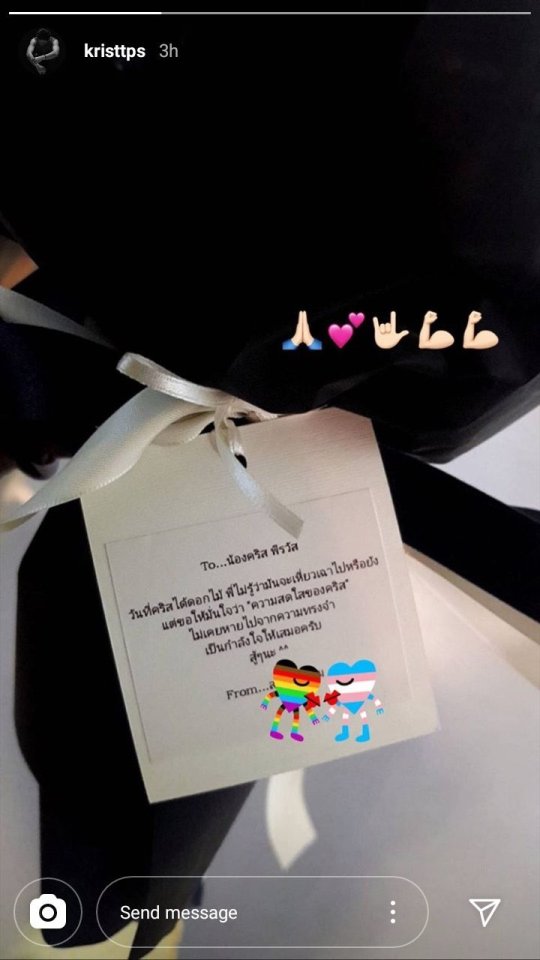
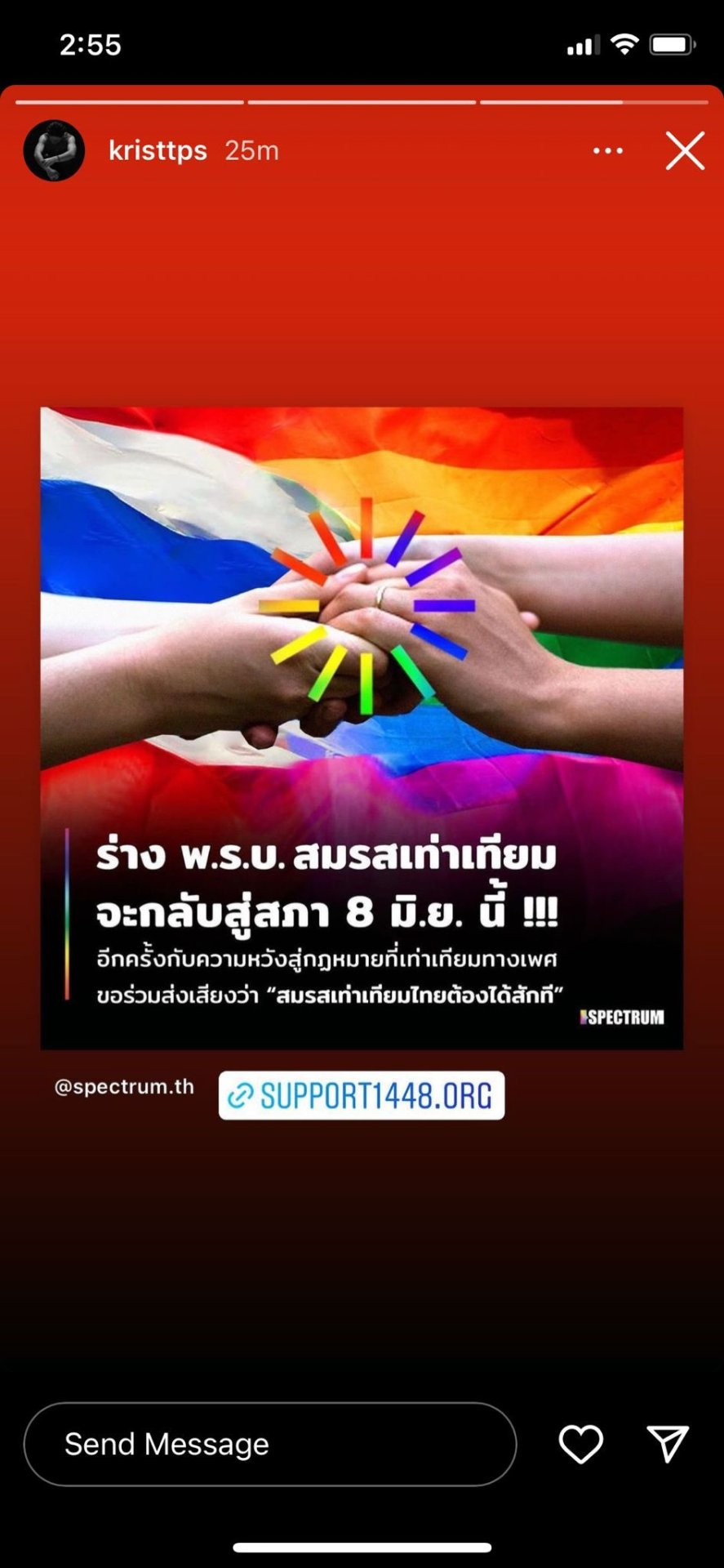
And, like many young people in Thailand, Krist also seems to support the Move Forward party. Earlier this week, he used an orange heart in a tweet to encourage people to go out and vote in the most recent election. One of the many things the Move Forward party is pushing for is the legalization of same-sex marriage "with the same rights and responsibilities as their heterosexual peers", which the current military government actively does not.
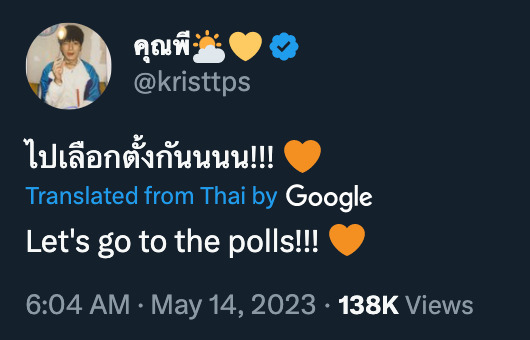
- His Circle -
When I was making my Twitter thread, I hesitated before including mention of his queer friends and coworkers. I knew how that would sound, but in the same way I felt it was important to mention my own queerness, I also think it's important to highlight not just the presence of queer people in his life, but how comfortable they are with him.
As I said in my Twitter thread, having queer friends isn’t indicative of anything substantial, but I do think it’s important to look at how those queer friends interact with him. If you’re queer, you know firsthand which friends you’d be physically affectionate with. The entertainment industry is its own world, of course, and the weight and meaning of relationships and connections can be different, but for all Krist's fame and popularity, he's not so famous or remotely powerful that faking a friendship with him is going to get them very far.
Among his queer friends, you've got Jennie who babies him, Godji who treats him like her son, and Oat who still adores him years after SOTUS. All of them queer, all of them visibly affectionate in a way that feels authentic, at least to me.

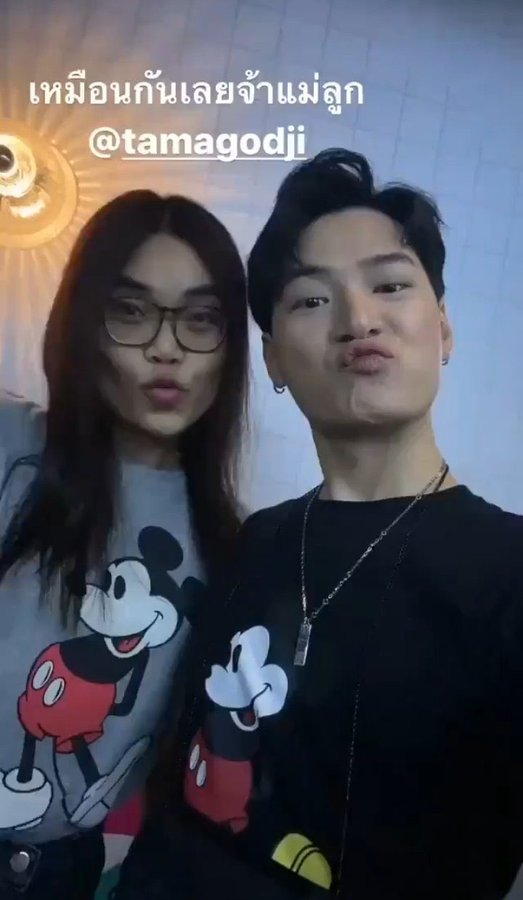
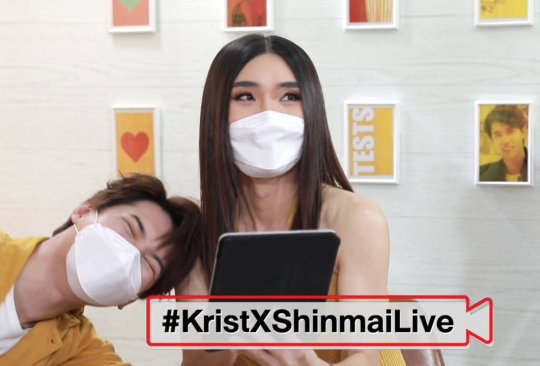
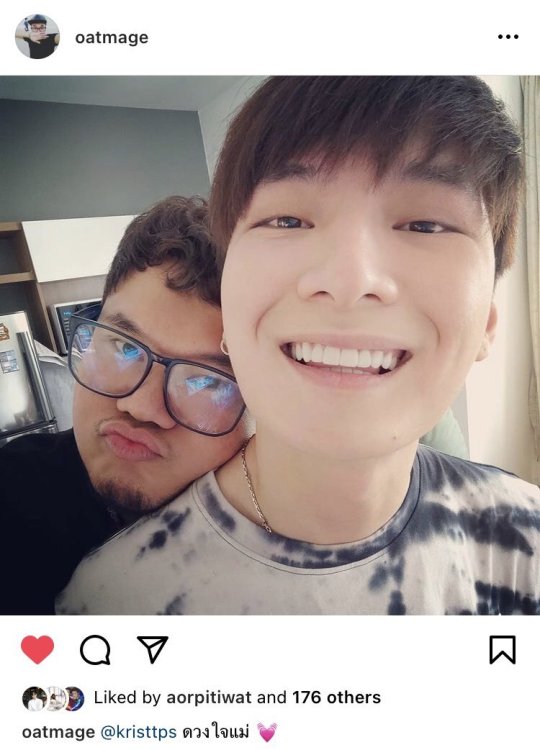
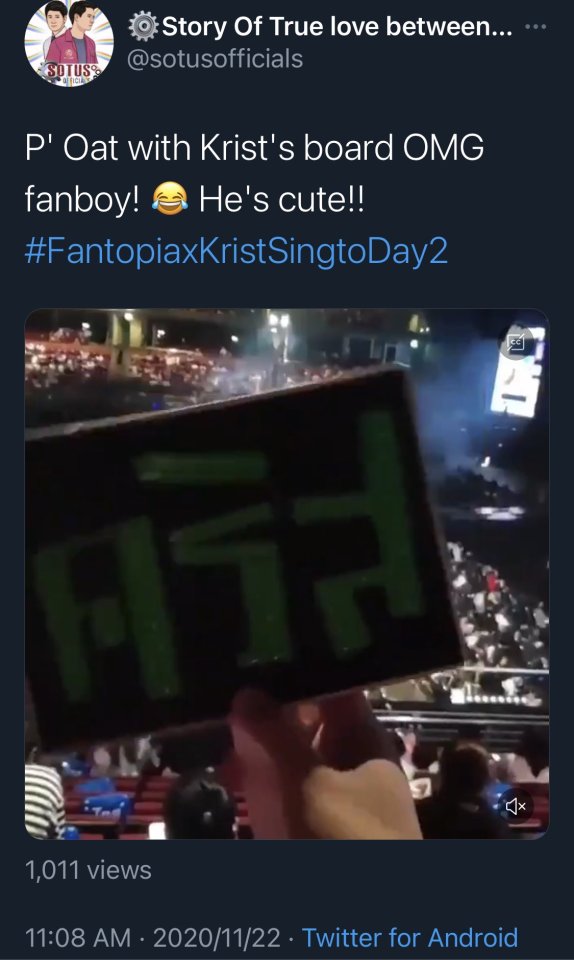
On the professional side of things, I think the best example of someone who wouldn't bother with him if he were homophobic is Golf Tanwarin Sukkhapisit. In 2022, Krist worked on The War of Flowers with Golf, a nonbinary queer activist, former MP, and director of The Eclipse. Since they're not just a queer person in the industry but a vocal queer activist who's made incredible progress for the community in their country, I value their judgment of his character.

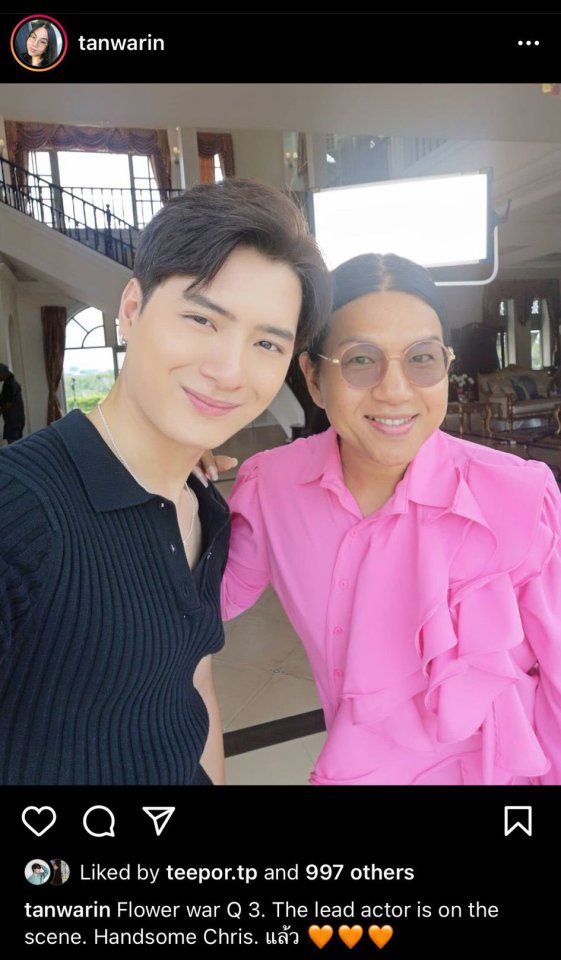
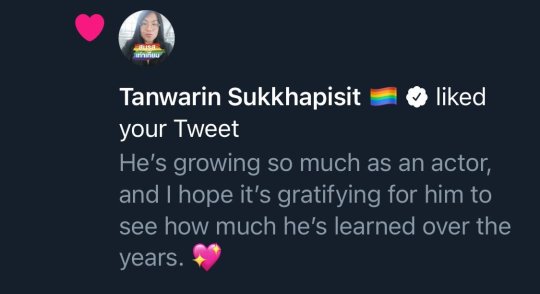
Again, the reason I bring up these people isn't to say, "Look! Queer people! He knows some!"
It's to point out that he's close to them, and it disrespects their judgment to casually assume that they’d cosy up to a homophobe.
It's a small point, yes, but it was important to me when I first became a fan to see that queer people who know him personally had "vetted" him.
- Growth -
For this next section, I'll address three things I see brought up most often: the rape filter joke, the rumor that Krist said he doesn't like watching men kiss, and the claim that he's only doing BL because rent is due.
1) The Rape Filter Joke
In 2017, Krist and Singto were on a live with (I think) two other friends. They were testing out different filters, and when they got to a blur effect, one of them (one of the friends, I think) said it looked like the filter they put over victims of sexual assault on the news. They all laughed, including Krist and Singto.
I can't find a video of the original event, but we do have a translation of the apology he gave in 2018, and the public apology he made in 2020 when the video resurfaced again.
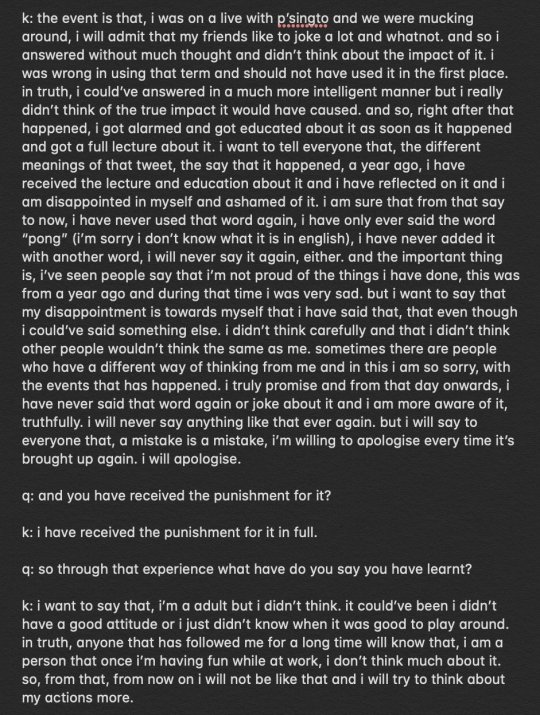
While this is unfortunate, and it would be nice if he hadn’t done it, I’m more interested in how he responds to criticism and his growth afterward. The incident was in 2017, but even speaking on it in 2020, he didn't make excuses for himself.
He apologized, accepted culpability, educated himself, and has never repeated it.
2) Krist "Doesn't Like to Watch Men Kiss"
There's also a claim that goes around that Krist said he doesn't like to watch men kiss. But that isn't what he said.
The subtitled interview that this claim was taken from has been split into two parts, and I think a lot of people have only seen the first half, if they've seen either.
(Also, my deepest apologies, but I'm linking you to Twitter for the video clips.)
In the first clip, the hosts tease Krist about Singto's sex scene with another actor in Close Friends. I can't speak to the nuances of what Krist is saying in Thai, but in the subtitles, he's basically saying that as a guy, he doesn't want to watch stuff like that and just skips past Singto and his partner to one of the other couples, like the male-female pairs. With just this clip, I agree that it doesn't sound great.
But in the second clip, the hosts tease Krist until he admits that the "stuff" he doesn't want to watch is Singto specifically kissing people who aren't him. Krist's jealousy, especially when it comes to Singto, is a well-trod fanservice joke.


3) He's Doing BL Only for the Money
I mean, I have no idea, but it'd be very weird if this was true, because he hasn't been in a BL since 2018 (if you count Our Skyy), and he's doing very well for himself financially.
Listen, this is probably the least serious people get when they criticize him, but I'm including it because why not, this is already a thesis.
From what I understand based on actors' comments, BL roles don't make a lot of money for the actors. (Boun even quoted a surprisingly low daily salary recently, and I'll share it here if I find it again.) Of course, I imagine Krist has enough fame and clout that he gets paid more than most actors, but to be frank, he absolutely makes more from all his other work.
Apart from the acting work he's done, he hosts two music shows, he starred in a musical recently, GMM just flew him to Japan for the first leg of his Asia concert tour, he runs a restaurant with Wave, and he has a bunch of sponsorships. And that's off the top of my head. The car from his accident in 2021 was a luxury model, and he replaced it with another pretty soon afterward. I'm not bragging for him or anything, but the "he's just doing BL for the money" is an odd thing to say when he probably already earns more than most without doing it.
It would have been a better argument back in 2016 when Krist's family was deep in debt. Krist's said that his main motivation to join the entertainment industry back then was to pay off that debt for his family, and he did so with the money he made from SOTUS.
Krist has spoken in the past about wanting to do more BL roles, but GMM preferred that he work with Singto. Now that Singto's left GMM (likely to start his own agency), Krist is in Be My Favorite, so I think his explanation tracks.
It's also worth mentioning that you can do something for the money and also love what you do. In the case of SOTUS, Arthit wasn't just a role that made him money, he's the character who changed Krist's life. He honors Arthit to this day by always wearing the bracelet he wore to his audition and by naming his music studio "SUN St." after Arthit.
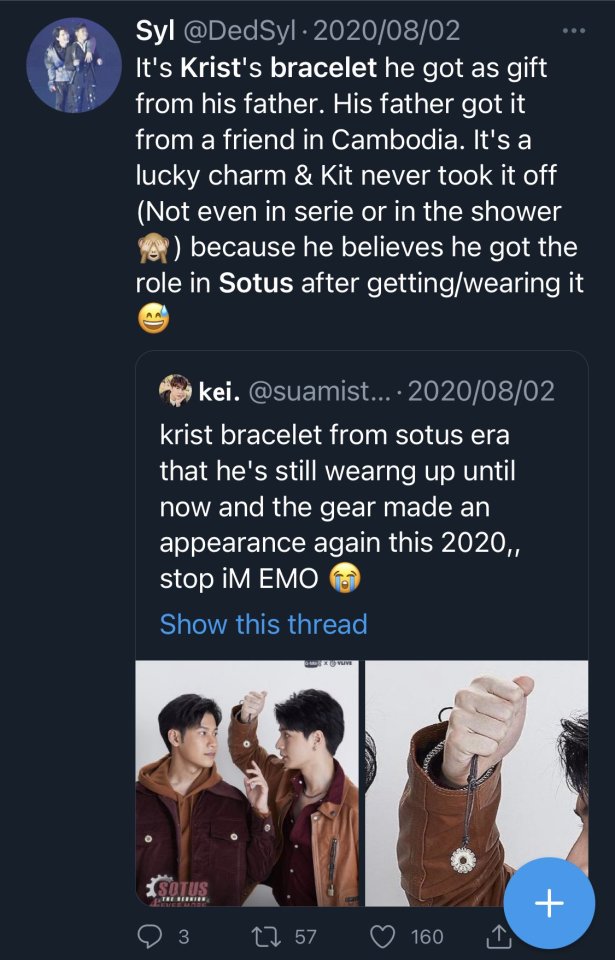

(This is a very minor point, but I don't think a homophobe would cherish a queer role to quite that extent even if it was their kick-off point. If anything, they'd probably try to bury the role and pretend their real success started later.)
- Perception of Sexuality -
I think the reason the IG story hits people so hard is because Krist's reaction makes it seem like he's horrified that people could even think he's gay. My understanding is that he was tired of people interrogating him about his sexuality.
Krist is very openly affectionate with the people he loves, regardless of gender, which is clear in the photos with his friends above. Thus, he's always been like that with Singto. They hug before every show, they sleep on each other, cuddle, what have you. All the stuff of people who have developed a tight bond over the years.
When Krist was asked if he was afraid that that would put off potential partners in the future (which, good god, the questions they're asked) Krist said he doesn't care how people perceive his sexuality.



This was in 2018, the year Our Skyy aired, and he's said similar things in passing before and since.
- Conclusion -
All of what I've posted here is just a slice of what's out there. This is just the stuff I could find with reliable English translations because I'm making this for an English-speaking audience. Krist's fans already know all of this, which is why he has queer fans in the first place, and a lot of them are just too tired by hate fatigue to keep correcting misinformation.
I'm not trying to get every person in the world to like Krist, I promise. He's not perfect. He's a loud mess, and while he has four cats who love him, they're also exhausted by him. I just happen to like loud, obnoxious people, especially when they're as kind as he is.
There are plenty of Thai actors I don't vibe with for any number of reasons ranging from serious to petty. You have my written permission to dislike some people.
The Instagram story he posted was a bad move, we're all agreed. He agrees. He's apologized multiple times over the years. Whether one accepts his apologies is each person’s right, and I understand if this is enough to turn people away.
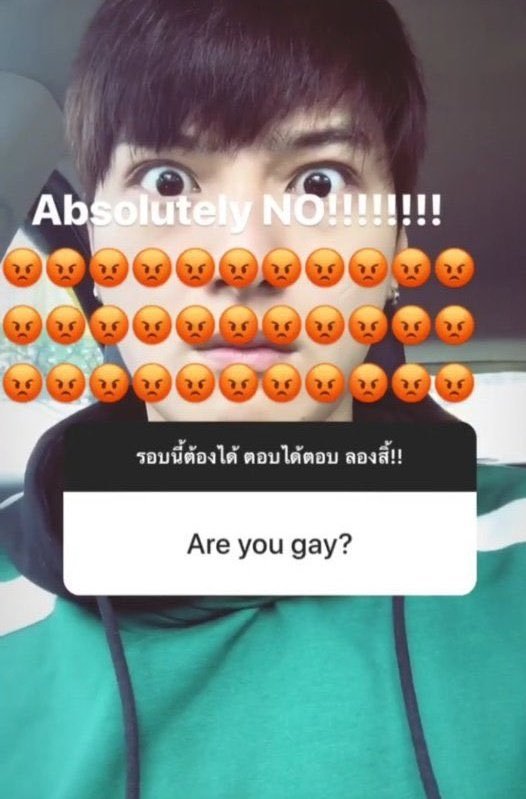
I just hope it's clear that he's been a staunch ally of the queer community and remains so to this day.
Personally, I'm more upset about the question.

This isn't a question you ask anyone.
And this wasn't the first fan to ask him.
According to people who have been fans from the SOTUS era, Krist and Singto were both relentlessly dogged by fans about 1) their sexualities and 2) details about their relationship with each other. We've all likely seen it happen to actors today, but back in 2016, there weren't hundreds of BL actors vying for the spotlight, so the spotlight hit Krist and Singto in a way that we can't imagine today. Most of us, myself included, arrived in this fandom long after SOTUS's meteoric rise to popularity that ended up saving GMMTV from bankruptcy, but given how many fans still behave like they're entitled to know an actor's sexuality, I think it's safe to trust that it was relentless. Fans accusing Kit Connor of "queerbaiting" as recently as 2022 is proof of that.
At the end of the day, there are plenty of reasons to dislike Krist, just like there are to dislike any person on this planet. He's hyperactive, he's whiny, etc. He's not flawless, but I think he's more than shown through his actions that he isn't homophobic, either.
He's not some actor playing queer roles for clout. He's vocally supportive of queer rights, and he backed that up this week in the polls by voting for the most progressive party in his country who are actively pushing for marriage equality.
But like I said, you don't have to like him, so I'll end this post with a quote from a friend who doesn't like Krist for the funniest reason I've ever heard:
"I don't think Krist is homophobic. I just don't like him because he reminds me of every kindergartener who demanded my attention at the exact moment when I was carrying something that could spill – and then it did spill, and they laughed about it for five minutes."
441 notes
·
View notes
Note
Hello! Do you by chance have any recs for blood thinner side effect fics (for Buck), or just generally long-term effects of any of his injuries/lingering conditions?
Like (can I post links? Idunno, the title is “a hundred little pieces” by renecdote)
https://archiveofourown.org/works/28948266
is absolutely incredible (highly recommend!) and I’m on the lookout. Thanks!
Hi! I've def got a few fics for you. Hope you enjoy!
These are all blood thinner related:
death by blood thinners by carefulren: Buck cuts his arm during a rescue, but he doesn't realize until Eddie walks in on him half-naked in the locker room and covered in blood.
Let That Lonely Feeling Wash Away by 221BSunsetTowers: After the fight with Eddie in the grocery store, Buck drops a glass jar and cuts his hand. Buck's just too tired, thinks he's just too tiring, to do anything but buy some gauze and plan on bandaging himself up at home. Buck's not really thinking about the blood thinners he's still on when the blood loss makes him collapse outside the store, right in front of Eddie.
Bleeding Isn't Optional for Most of Us by actually18pigeons Summary: In the midst of recovering from the leg injury, Buck relapses with self-harm, but the blood thinners make that a bit more of a problem than he anticipated. So what does he do as he's bleeding out on his bathroom floor? Call Eddie of course. Major self-harm trigger warning. Be careful please.
Shaving Gone Wrong by DawnNimbus Summary: Buck not paying attention at work before shift and cuts himself shaving. Eddie freaks out because of the blood thinners. Buck had forgotten to tell the team had been off them for a while.
---------------------
These are all Buck having chronic leg pain after being crushed under a firetruck:
Flare Up by actually18pigeons Summary: Off of a chronic pain prompt - Buck has a flareup sometime between healing from the accident and being reinstated. Pre-lawsuit, pre-Buddie (but there's definitely mutual feelings).
Attack from Behind by Shearmouth Summary: For Whumptober Day 6: "Stop, please." Most days, it's nothing. A twinge if he lands on it wrong, an ache during rainstorms. Other days, Buck can't breathe.
featherlight by rogerzsteven Summary: "Can you come over?" Buck asks over the phone— he pleas, and the tremble in his voice clenches Eddie's heart. "Where are you?" Eddie springs to his feet, grabbing his coat and keys in a rush, his brows knitted and face suddenly burning up. "Are you okay?" Eddie hears another choked out mewl over the line. "I'm— I'm home." "Are you okay?" "I'm—" Buck's words get cut off by a pained groan. "God, my—my leg— I c-can't get up." 1 time Buck tends to Eddie's shoulder pain and 1 time Eddie tends to Buck's leg pain. Bad Things Happen Bingo: Chronic Pain
eddie diaz saves the day by buckaroobuddie Summary: Buck's leg acts up as he's trying to rescue someone. Eddie's there to save the day. ---- Written for the prompt "Chronic pain"
cause i will be your safety by rogerzsteven Summary: "Is it your leg?" Eddie whispers as he gives Buck's shoulder blade a gentle squeeze. Buck nods his head without even lifting his face from the pillow and whimpers quietly. Eddie sits on the edge of the couch, wraps his fingers around Buck's leg and scoots closer so he can rest Buck's leg on his lap. "Hey." Eddie says when Buck tries to get his leg free from Eddie's touch. "Let me see." Buck has a leg cramp. Eddie helps him as he can. bad things happen bingo: crying into chest
---------------------
These are all post tsunami nightmares and panic attacks:
Fall On Me by lionheartedghost Summary: “You never used to go this way,” Eddie said. “It’s quicker to take a left back on Pine and go along by the ocean.” “This way’s quicker,” Buck said absently. “Cuts out the traffic.” “No it doesn’t.” Eddie looked at him carefully. “It just cuts out the beach.” Written for the promptabuddie prompt, "Eddie helps Buck deal with his fear of water following the tsunami."
Bring Me Back by Stennerd Summary: It's been months since the tsunami and Buck had been doing just fine. All it took was walking through water to bring it all crashing back.
Bucky bear by wolfypuppypiles Summary: Buck is still struggling with nightmares after the tsunami and Eddie and Christopher come up with a plan to help him feel safe at night.
Ghost in the night by wolfypuppypiles Summary: So, apparently one of the side effects of trauma can be sleepwalking. Yeah. Buck thought it was pretty weird too. Queue worry, angst, baby gates and pep talks :)
98 notes
·
View notes
Text
SAG-AFTRA is Ready

[Image ID: A tweet from Bethany Anne Lind (@LindBethanyAnne) from July 12th, 2023 that reads:
Hi. You’re looking for the “rank and file” actors? We’re here. Very easy to find. Lots of IMDb credits. Few shits to give if we ever work for the AMPTP’s pennies again. @sagaftra /End ID]
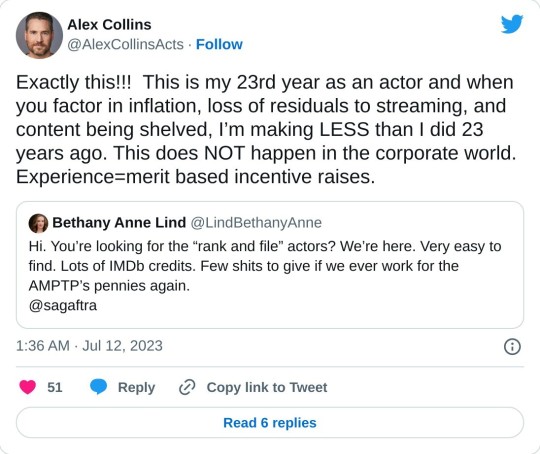
[Image ID: A QT of the first tweet by Alex Collins (@AlexCollinsActs) from July 12th, 2023, that reads:
Exactly this!!! This is my 23rd year as an actor and when you factor in inflation, loss of residuals to streaming, and content being shelved, I’m making LESS than I did 23 years ago. This does NOT happen in the corporate world. Experience=merit based incentive raises. /End ID]

Sorry I can't get all of the tweet. Those links used to take it to where you could read the whole thing, now you have to sign in again. Stupid broken Twitter.
Anywho, the beginning of Vincent D'Onofrio's tweet reads:
Attention @sagaftra stay strong actors. Do not let the higher echelon of our peers convince us otherwise. The writing is on the wall. Solidarity is staring us in the face. Eyes are on us let's finally be the Union we should have always been. This is no joke this is our moment of…
If anyone can get the full thing, that would be great!
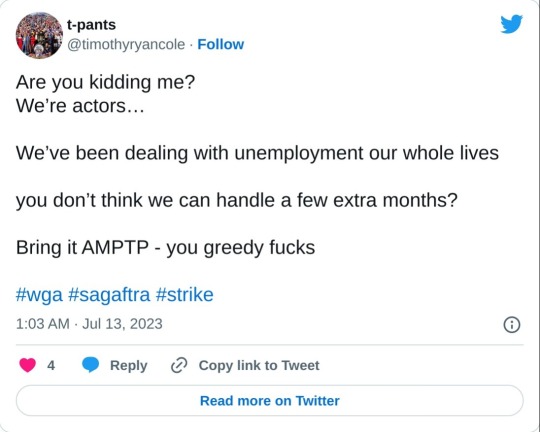
[Image ID: a tweet from t-pants (@timothyryancole) actually just posted on July 12th, 2023 that reads:
Are you kidding me?
We’re actors…
We’ve been dealing with unemployment our whole lives
you don’t think we can handle a few extra months?
Bring it AMPTP - you greedy fucks
#wga #sagaftra #strike
/End ID]
Not SAG, but this is a good one too:
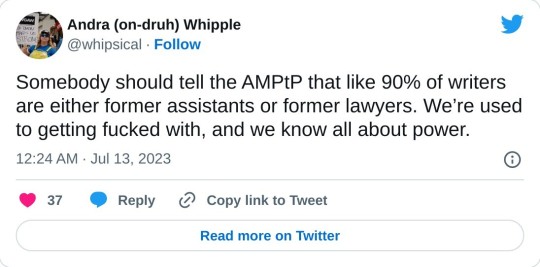
[Image ID: A tweet from Andra (on-druh) Whipple (@whipsical) from July 12th that reads:
Somebody should tell the AMPtP that like 90% of writers are either former assistants or former lawyers. We’re used to getting fucked with, and we know all about power. /End ID]

[Image ID: Tweet from Rukhmani K. Desai (@/rukhdesai) from July 12th, 2023 that reads:
Lol SAG gave the AMPTP a self-tape due in less than 24 hours. At least 40 pages of stuff to look over and said “good luck to you on that.” /End ID]
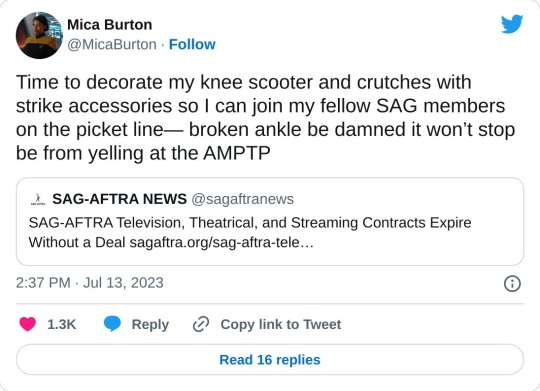
[Image ID: a tweet from Mica Burton (@micaburton) from July 13th that reads:
Time to decorate my knee scooter and crutches with strike accessories so I can join my fellow SAG members on the picket line— broken ankle be damned it won’t stop be from yelling at the AMPTP /End ID]
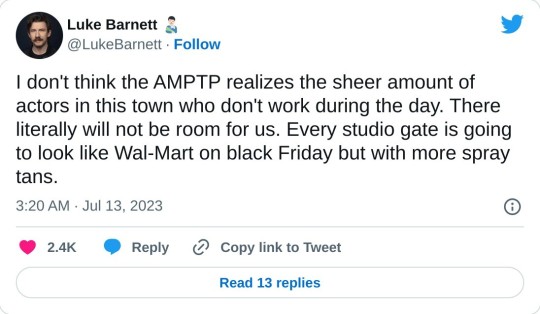

[Image ID for the above set of tweets: two tweets from Luke Barnett (@/lukebarnett) posted July 13th, 2023 that read in totality:
I don't think the AMPTP realizes the sheer amount of actors in this town who don't work during the day. There literally will not be room for us. Every studio gate is going to look like Wal-Mart on black Friday but with more spray tans.
Like, I'm literally going to be showing up with a mini-van of dads from my kid's preschool who are all out of work working actors. Traffic within a mile of any major studio is going to be a nightmare. WE HAVE NOTHING TO DO. /End ID]

[Image ID: A tweet from Shawna Benson (@shawnabenson) from July 13th, 2023 that reads:
Day 73 for WGA.
Day Zero for SAG (a lot of people will count it as Day One, and rightfully so).
WE are waiting for the AMPTP to negotiate in good faith. They can't ignore most of our demands (decline to counter) and say we walked away from the table.
THE STUDIOS did this.
/End ID]
#wga strike#sag aftra strike#bethany anne lind#alex collins#vincent d'onofrio#timothy ryan cole#andra whipple#rukh desai#mica burton#luke barnett#shawna benson
47 notes
·
View notes
Photo

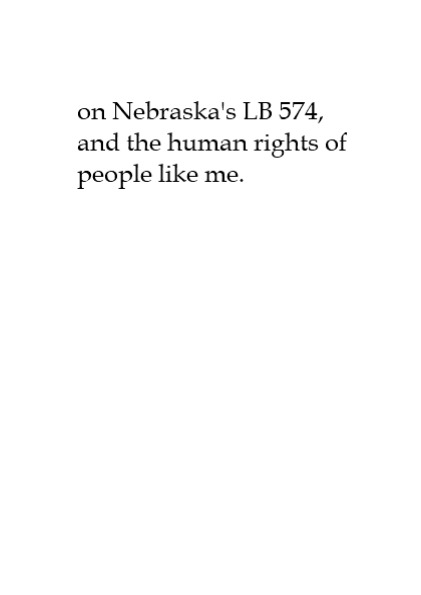
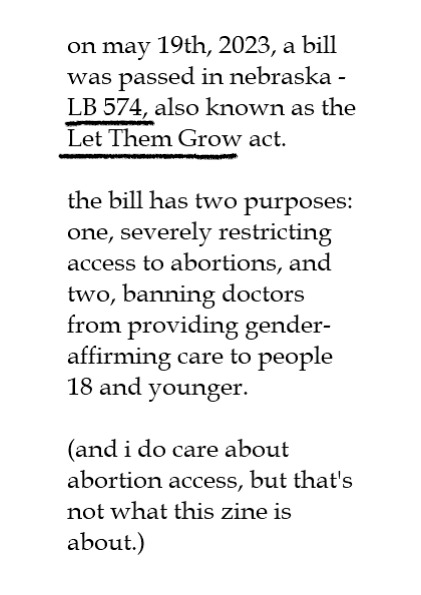


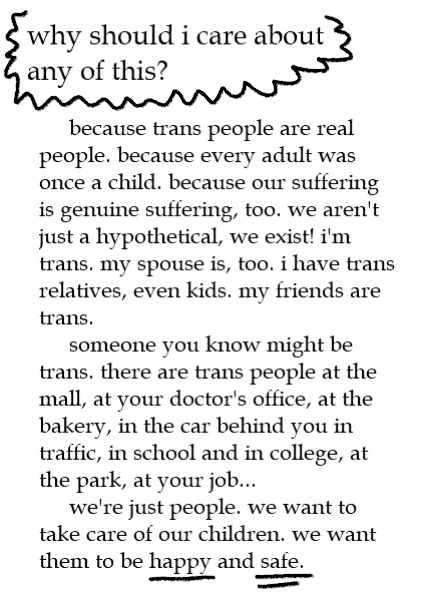
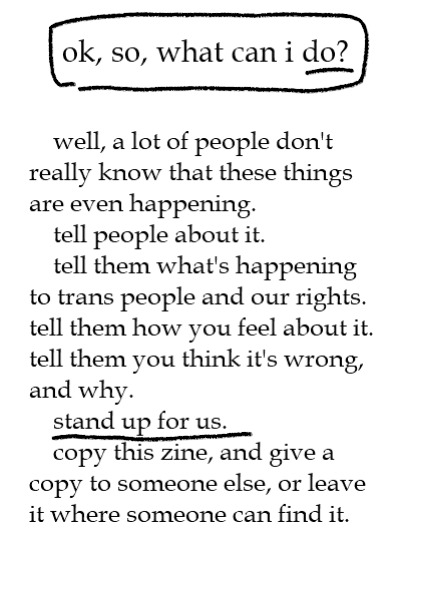

the entirety of the zine i mentioned in a prior post. in order: front cover, back cover, and pages 1-6.
image descriptions follow.
all pages are black text on white background.
front cover has large text reading: OMG, did you know?...
back cover text reads: on Nebraska's LB 574, and the human rights of people like me.
page 1 text reads: on may 19th, 2023, a bill was passed in nebraska - LB 574, also known as the Let Them Grow act.
the bill has two purposes: one, severely restricting access to abortions, and two, banning doctors from providing gender-affirming care to people 18 and younger.
(and i do care about abortion access, but that's not what this zine is about.)
page 2 has a header reading "what is 'gender-affirming care'?" and the remaining text reads: this refers to medical treatments which help transgender people to feel more comfortable with our bodies, and help us to be protected from violence by helping us blend in. this can include puberty blockers, hormone replacement therapy, and sometimes surgeries.
most major medical organizations are in agreement that providing GAC to kids who want it is the best choice for their well-being, and causes MORE GOOD THAN HARM.
page 3 has a header reading "but it's not a big deal, right? i mean, so they just have to wait until they turn 19, so what?". under this, it says "how about a thought experiment:" and branches into two columns, with an arrow pointing to each. on the left: "WOMEN - how would you feel if you started growing a beard and moustache when you were 14, and your voice dropped? what if everyone called you sir?". on the right: "MEN - how would youfeel if you started menstruating & growing breasts at 11, and you never grew facial hair even when your friends did? what if everyone called you ma'am?"
then the two columns both point to a paragraph below, which reads: what if there were safe, effective medications that could make this stop happening, but you couldn't take them until you turned 19? it probably wouldn't feel good. you might feel hopeless, even suicidal. that's what proponents of LB 574 are forcing trans kids to endure.
page 4 has a header reading "why should i care about any of this?", and the remaining text reads: because trans people are real people. because every adult was once a child. because our suffering is genuine suffering, too. we aren't just a hypothetical, we exist! i'm trans. my spouse is, too. i have trans relatives, even kids. my friends are trans.
someone you know might be trans. there are trans people at the mall, at your doctor's office, at the bakery, in the car behind you in traffic, in school and in college, at the park, at your job...
we're just people. we want to take care of our children. we want them to be HAPPY and SAFE.
page 5 has a header reading "ok, so what can i DO?", and the remaining text reads: well, a lot of people don't really know that these things are even happening.
tell people about it.
tell them what's happening to trans people and our rights. tell them how you feel about it. tell them you think it's wrong, and why.
STAND UP FOR US.
copy this zine, and give a copy to someone else, or leave it where someone can find it.
page 6 reads: you can go to this website or scan this QR code to get some resources.
[here there is a QR code]
butchdog.itch.io/574-zine
the "download now" button, and you'll get access to 1) a .PDF file of this zine, so you can print and distribute your own copies, 2) a .PDF file with links to more information, and 3) instructions about printing your own copies of this zine.
end ID.
41 notes
·
View notes
Text
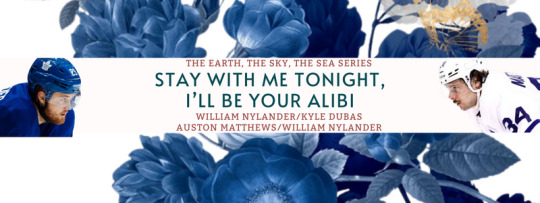
Title: stay with my tonight, I'll be your alibi (Part 7 of the earth, the sky, the sea) >> AO3 Link
Rating: Explicit
Pairing: Auston Matthews/William Nylander, William Nylander/Kyle Dubas
Tags: POV Alternating,complicated relationships, Willy dealing some angst
Summary:
They play Pittsburgh - they play Kyle Dubas.
Willy deals with the aftermath of feeling like he's being forgotten.
They haven’t talked.
There’s a lot of things that they should probably talk about, like does Auston want all the sweaters he keeps leaving here? But then he thinks about Auston meticulously packing up his stuff around the apartment and he drops that thought immediately.
It’s stupid. He’s the one that walked away, but he slips on one of those sweaters now, tucks his nose into the collar.
He cleans his apartment. He can’t bring himself to pack anything of Auston’s away, but he can at least turn the photographs so it doesn’t feel like Auston’s watching him have his pathetic post-breakup meltdown. Or whatever.
He hasn’t had to do this before. Before Auston, there was Kyle and despite their back and forth, that relationship just came to a natural end. And then Kyle left.
Will wasn’t — isn’t — the type of person who can do long distance for the majority of the year. He needs to be touched and held and told he’s loved face to face.
He misses Auston so much already it aches but he knows it was for the best.
═══
Auston doesn’t know what he’s supposed to think, or say, or do. He’s just been staring at the last messages between him and Will.
It was all so normal.
═══
Will tries not to react when Mitch turns away before he’s even done speaking. Fine. Fuck you, too.
He settles himself — that’s now what he thinks about Mitch. He just doesn’t like what this is doing to him. Doesn’t like that it makes him bitter and unfocused, doesn’t like that it makes him love the game less.
Doesn’t like that it makes him want to fucking himself headfirst into the incoming traffic of his emotions.
Don’t do it. Don’t do it.
He does it anyway.
“Willy?”
“Hey. Do you wanna meet me in an hour?”
═══
The air in his lungs just vanishes. Not exhaled, not stolen in some romantic manner. Just gone.
He tries not to feel anything. At all.
He fails.
“Hi Willy,” Kyle says, his voice soft and soothing.
“Hey,” he responds, stepping back so Kyle can enter.
“I was surprised to see you call.”
“Uh, yeah, I’m —” What was he? Sad? It seems more complicated than that. “I just — wanted to see if you were okay.”
“Of course. Always am.” Kyle gives him a small smile — but it’s tired. So fucking tired.
Willy feels for him, really, because he knows it’s not okay. It never is. “You don’t have to lie to me,” he says. It comes out softer than intended. It sounds too much like he cares.
And he does. He wants Kyle to be happy, he wants Kyle to have everything that Kyle deserves and has worked for.
He wants Kyle to win. Just not tonight, and somehow, that makes him feel guilty. It shouldn't, but it does.
Kyle shrugs. “It’s the game. You know how it is.”
That’s as close to I’m not okay as Kyle will ever get, he supposes. Pablo shoves his face between Will’s legs to look up at Kyle.
“Yeah, but —” he pauses as he watches Kyle take his jacket off. Kyle looks good. “But it still… sucks.”
Yeah, he’s super articulate tonight.
Banksy pushes past both of them to try and jump on Kyle. He should probably stop that, but Kyle’s smiling down and cooing Banky’s name and Will’s going to lose his whole ass mind.
“Drink?” He offers instead, trying not to tune his hearing into every step and every breath Kyle takes.
“Just water‘s fine.”
It feels a lot like their last conversation.
“How is everything?” Kyle asks, and well, isn’t that a loaded fucking question.
“Fine,” he says, even though it’s so far from the truth.
And of course Kyle knows. Neither of them let go of the bottle as Will goes to hand it over. His fingertips are cold from the water, but Kyle’s hand feels like a bonfire, warm and enticing.
“Willy.”
He lets go. Kyle lets go.
The water bottle drops with a dull thud. And then Kyle’s holding him.
His first inhale feels like he’s underwater, and he chokes it back out, all the anger and sadness inside of him just pouring out of him.
“I’ve got you, baby, I’ve got you.”
And he does. Kyle does have him, arms strong and unmoving around Will’s heaving shoulders.
“It’s okay, it’ll be okay,” Kyle continues. “Just let it out.”
So he does.
═══
“Do you want…”
“Yes,” Will responds, cutting off the rest of the sentence.
“Are you sure, baby? I mean — Auston?”
He huffs at the name. “Fuck Auston,” he says bitterly, trying to pretend like he isn’t wearing one of Auston’s shirts right now.
Kyle’s eyebrow arches, but he doesn’t push. He doesn’t make Will feel stupid about it, he just pushes closer and closer until the two of them are tumbling onto the couch.
“Please, Kyle, I —”
“Gotta get outta your head. I know, baby.”
“Just — please.” His eyes burn with the embarrassment of it all — of breaking down in front of his ex, who he’s supposed to show that everything’s fine. But instead he’s almost hyperventilating as he asks for some form of salvation.
═══
He forgets about Auston, for a second. He forgets everything, really.
His own name. Where he is. What he’s doing.
Kyle blows him so good he nearly blacks out. Then he fucks Will’s face like he’s not about to be one of the highest paid players in the league.
Kyle fucks him like he’s nothing, because he asks for it and wants it — because he feels like it.
Kyle fucks him until he cries. He doesn’t safe word. Kyle stops anyway.
He tells Kyle it’s best he doesn’t stay the night. Kyle stays anyway.
There’s a text from Auston when they go to sleep — miss you — but Kyle’s arms are warm and Kyle’s heart beats steady against Will’s back.
Kyle’s here.
So fuck Auston and his stupid text.
Look at me, I’m fine without you.
#william nylander#auston matthews#kyle dubas#auston/mitch/nylander#163488#3488#william nylander fanfiction#william nylander/kyle dubas#hockey rpf#men's hockey rpf#nhl
5 notes
·
View notes
Text
Hawaiian Symbolism, Morgan, TWD Food Videos, and Emily Being in Savannah
More symbolism and SM convos:
@galadrieljones:
Norman did post something the other day, two young actors who are clearly involved in the spin-off, as they were dressed in like ragged apocalypse clothes. One of them was playing and singing Wonderwall by Oasis on a ukulele and looked a little like that actor.
@wdway:
Ummm, Daryl saw a ukulele in the subway tunnel in Acheron Part 2.

@galadrieljones:
Okay just so much TWD stuff on insta today. They’ve been making these cute little promotional videos by AMC that have humorous themes. Todays was “famous food from the walking dead.” Lots of funny things like Dwight’s club sandwich, Carol’s cookies, Jerry’s cobbler, Negan’s spaghetti, etc. Also featured are Daryl’s snake jerky, with Beth yet again featured saying the line (“Enjoy you snake jerky…”) and also featured was White Trash Brunch from Alone. So much Beth love.
She is the only character to be shown in two different famous food scenes !
True!! The Hawaii reference. Dales RV is like full of Hawaii references, too. Hmm.
Also the Hawaiian dancer on the dash of Isobel’s helicopter? Am I remembering that right?
Or no, the van, the MRAP, has a Hawaiian dancer on the dash.
@wdway:
The hula dancer and also with a ukulele there was a sign saying aloha.

@galadrieljones:
Something important here for sure. Definitely a link to the CRM.
@wdway:
Tarah, what things in Dale's RV that were Hawaiian references?
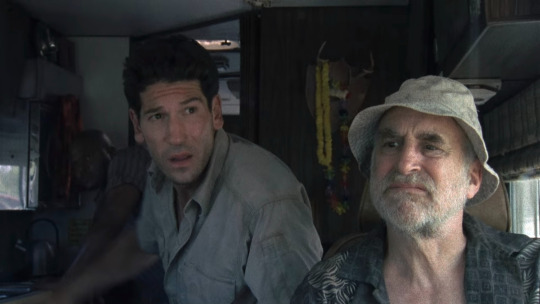
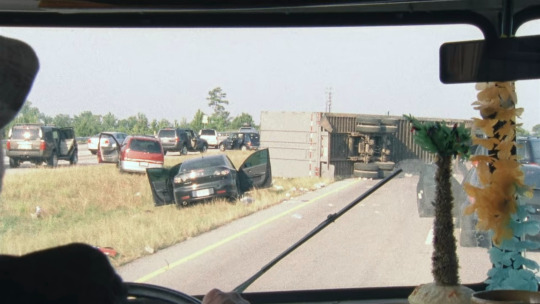
@galadrieljones:
Trying to find my screenshots!
What Lies Ahead

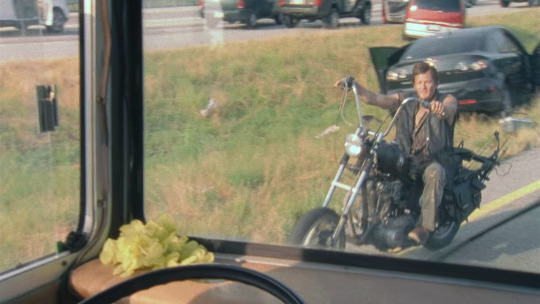
@wdway
Am I correct in what you said about the food that there were two favorite food clips from Daryl both included Beth?
@galadrieljones:
Yes you are! Snake jerky and white trash brunch.
Here’s a link to the reel! Idk if you can watch without an acct but you can try https://www.instagram.com/reel/CoIom-RPdbp/?igshid=YmMyMTA2M2Y=
@wdway:
I never noticed. I love that they're all Beth colors.
Thanks for the link I was able to watch. That's so cool. It's as if they want us to associate Daryl with Beth.
@galadrieljones:
Right I was trying to think of other Daryl foods. The peanut butter in Dwight’s room at the sanctuary came to mind. Ofc that’s a callback to white trash brunch.
@wdway:
Definitely or a reminder again of Beth since she's the one in Alone that took the peanut butter.
@galadrieljones:
It’s so devastating. Hearts Still Beating is such a major moment of descent for Daryl. How they corrupt the peanut butter, a Beth symbol, to show how he doesn’t enjoy it. He’s just like shoving it in his mouth for survival. He then kills that guy in cold blood. Peanut butter is also a Morgan thing. Why is he so connected to Beth??

@wdway:
Morgan is definitely connected to Beth. I've always thought he found her when she was left in the car after Grady. But that's a very long ramble that's been rambled many times, haha.
@galadrieljones:
That would definitely be cool. I also feel it means he could see her first, recognize her. Morgan is often seen around arrows and traffic signs. I know I’m a broken record but I see him as a navigator. Like someone to follow closely. He knows the way. I read some of the old theories about how he had gurneys at his hideout.
That maybe he knew about Grady or had heard something about it. Like maybe he and Dwayne were trying to get there. Maybe he was near Atlanta when he found her. Afterward he ended up at Terminus, followed the carvings to the church. I can’t remember if there’s any indication as to where Eastman lives. The woods between Macon and Atlanta seem endless.
It’s always been interesting to me that he encounters Daryl first when he gets to Virginia.
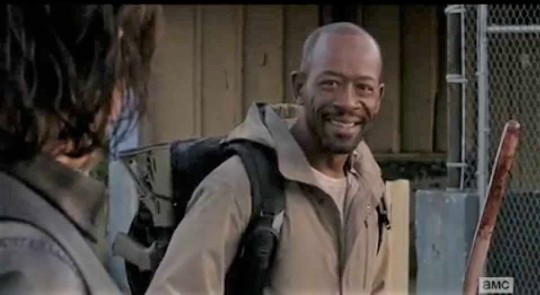
Oh and per Morgan’s arrows, twice they are specifically yellow. There are arrows with yellow fletching in Clear and a big yellow arrow in Eastman’s house. He’s also seen in front of yellow traffic arrows in Good Out Here, the episode of Fear where Nick Clark dies. It’s maybe a yellow brick road reference. But I think it also is meant to conjure out memories of Beth, who wore yellow. Daryl is also seen with the arrows with yellow fletching. They’re at his house in Alexandria near his work bench.
Sorry I said twice above but it’s really three times lol.
@wdway:
It's funny that you see Morgan as a Navigator. I have always thought of him as a prophet which is very similar if you think about it. I just have always felt that there's too many hints around Morgan that relate to Beth that there has to be some type of connection.
I was just thinking the other night with the announcement that this is the last season of Fear and how this is also the first season that they filmed in Savannah, Georgia and how we saw that posting of Beth excuse me Emily taken in Savannah. She said she was in Savannah at a wedding. In the picture she was wearing the same top that she wore on TTD the first time of the two times that she was a guest for s11. We know how she loves to tell us exactly where she is. Unless she doesn't want us to know where she is. I guess all these little things laid up to I really am looking forward to Fear and what it might reveal.
@twdmusicboxmystery:
Same! It would be SOO cool if she showed up in Fear. EVERYone would then tune into the Daryl spin-off bc we would know she was alive but also would know that Daryl doesn’t. That would be awesome!

@galadrieljones:
I also love Morgan as a prophet. With all his breaking the fourth wall instances, he’s like a prophet to tptb. Through a Biblical lens I see him as the prophet Jonah, the original Christ archetype who tried to avoid his responsibilities and ended up being caught in a storm and swallowed by a whale.
Also I agree with you both about Fear. I almost feel it would be too good to be true if she showed up there.
But like I can’t forget how she was in Savannah. And she was wearing that sweater. I remember too it was weird because she posted herself in Savannah, then like a week later she posted herself in a cute dress for her hallmark movie promo tour.
She mentioned specifically she got the dress in Savannah where she had been for a wedding. It just felt weird like that maybe someone had said something, like be careful ppl will pick up on the fact you were in Savannah. And so she felt the need to say why she was there. She never said why she was in Montreal for example. She posts herself in a lot of locations with no explanation. So why Savannah?
@wdway:
I have had the exact same thoughts about Emily mentioning Savannah. It just seem so purposeful of a explanation of why she was where she was when normally she might state where she is without an explanation as you mentioned about her being in Montreal. It almost felt like it was over thought about. How people might realize that she was in Savannah at the same time as Fear was filming and think it was a bit of a coincidence.
It's like someone loudly saying "don't look, don't look" which only makes you look more closely. The other coincidence was in the picture she is wearing the TTD sweater. I don't remember anyone mentioning that she had worn it in many pictures from other locations. Just a lot of litte odd things that makes a person wonder.
Speaking of wondering has there been any more mention of Montreal and what she was working on?
@galadrieljones:
Agreed!! Also per Montreal, there’s been no mention specifically. However she has a new hallmark movie coming out, and I am wondering if that was it.
#beth greene#beth greene lives#beth is alive#beth is coming#td theory#td theories#team delusional#team defiance#beth is almost here#bethyl
8 notes
·
View notes
Text
youtube
Why Podcasting is the Secret Weapon for SEO and Personal Branding
Hey Tumblr fam! 💫 If you’re in the game of growing your brand, you’ve probably tried everything—ads, blogs, social posts. But have you ever thought about podcasting? It’s not just for entertainment; it’s a powerful tool that can transform your SEO and elevate your personal brand.
You see, podcasting is like having a long, deep conversation with your audience. It builds trust, something that’s nearly impossible to achieve with a 30-second ad. And trust? That’s what converts followers into loyal customers.
The SEO Magic of Podcasting
Let’s dive into the SEO side of things. We all want to rank high on Google, right? But SEO can be a tough nut to crack. The good news? Podcasting can give you a major boost. Every time you appear on a podcast, you’re getting a backlink to your site. That’s like SEO gold! 🌟
Here’s how it works: Imagine you guest on 100 podcasts. Each one of those episodes links back to your website. Google sees all those backlinks and thinks, “Hey, this person must be important!” Your site starts to rank higher, and suddenly, you’re getting more traffic than ever before.
And it gets better. You can take the transcript from each podcast episode, turn it into a blog post, and boom—now you’ve got even more content that’s searchable. Your SEO goes through the roof, and all you had to do was talk about what you love.
From Podcasts to the Big Screen
But podcasting isn’t just about SEO. It’s about sharing your story and building your authority. I’ve seen it happen firsthand. During the pandemic, I wrote a book and started guesting on podcasts to promote it. Little did I know that this would lead to something big—like Hollywood big 🎬.
After being on hundreds of podcasts, my story caught the attention of a major motion picture studio. That’s right, a movie deal, all from sharing my journey on podcasts.
And it’s not just me. We helped Fred Joyle, the creator of 1-800-DENTIST, get on over 75 podcasts in just one month. The result? His book became a bestseller, and his speaking gigs took off like never before.
Don’t Go It Alone: The Importance of Professional Podcast PR
Now, a word of advice: If you’re serious about your brand, don’t try to handle your podcast PR on your own. It’s like trying to sell your house without a realtor—not a good idea. Podcasting is all about relationships, and that’s where a good PR agency comes in.
At Podcast Cola, we’ve spent years building relationships with top podcasts. We know how to get you on the best shows and make sure you shine. We even guarantee placements—something you won’t find with most PR firms.
Affordable, Guaranteed Results
So, how much does it cost to get started? Traditional PR can cost a fortune, with no guarantees. But we offer full-service podcast PR for just $1,497 a month, with unlimited pitches and placements. It’s an incredible deal for anyone looking to grow their brand 🎉.
If you’re ready to see what podcasting can do for you, let’s chat. We offer a free 15-minute consultation to see if podcasting is right for you. Head over to PodcastCola.com to book your call and start making waves in the podcasting world.
1 note
·
View note
Text
Color Me Equal: Why Crayons Have More Diversity than Society
by Jayhan Ambrocio, Samantha Abigail Santos, and Lujille Talanquines
Are you racist? If yes, then this blog is for you.
What is racism anyway?
Racism is all about prejudice and discrimination based on race or ethnicity. It can be blatant like hurling insults, or sneaky like microaggressions (think backhanded compliments about your hair). Racism also exists on a systemic level, where policies and institutions disadvantage certain racial groups.
Jayhan will guide us through the kinds of racism!
Ever wonder why lighter skin is sometimes seen as more desirable? It traces back to colonialism, where lighter skin was associated with the colonizers who held power. This warped thinking fuels colorism, where people of color with darker skin tones face prejudice.
“You think the only people who are people are the people who look and think like you.” This is a line in a song entitled “Colors of the wind” which is a soundtrack in a disney movie entitled Pocahontas. This is what I think of every time I hear derogatory comments from classmates, friends, or posts on social media.
From the casual conversations and social media posts to the widespread obsession of skin whitening products. These few occurrences in the Philippines cause confusion about what defines appropriate behavior and racial discrimination.
Growing up, I witnessed how some of my friends would laugh at black people for simply being who they are, even going so far as to call them "negro" or worse.
Whenever our province-based students speak and recite in class, the majority of my classmates at school laugh. Sometimes, they would even ask him to repeat what he said only to laugh at him again. These circumstances where students get bullied inside the class because of their ethnicity is not foreign in the Philippines, it happens quite often.
You see, racism is all around us. We can literally see it everywhere - on social media posts, casual conversations, and even places where people should foster inclusivity.
Moreover, the Philippines is a home for several races and ethnicities, it's not unusual to see Indians, Chinese, and other races in the Philippines. It was particularly concerning how many derogatory remarks were directed at these individuals. This circumstance overlaps with the stereotypical perception of Filipinos when it comes to other races. If someone is Indian, they offer or do lending business. If someone is Chinese, they offer fake products and they are instantly linked with feng shui and fortunate charms.
Racial/Ethnic Profiling: Suspected Before You Even Speak? Sam will educate us about it.
You're walking down the street, minding your own business, when you're suddenly stopped by the police. They ask you questions, search your bag, or even detain you – all because of your race or ethnicity. This is racial profiling, a discriminatory practice where individuals are suspected of criminal activity based solely on their appearance.
Is this even real? Well, the numbers don't lie:
A 2023 report by the ACLU (American Civil Liberties Union) analyzed data from over 20 million traffic stops across the US. It found that Black drivers were pulled over at a rate 2.3 times higher than white drivers, despite having similar violation rates. Latinx drivers were also stopped at a disproportionate rate (1.3 times higher than white drivers).
Indigenous communities in the Philippines, like the Aeta and Igorot people, often face profiling due to stereotypes and misconceptions. A 2021 report by Human Rights Watch documented cases of Aeta individuals being harassed and detained by security guards based solely on their ethnicity.
In 2020, Ahmaud Arbery, a young Black man, was chased and murdered by three white men in Georgia while jogging, allegedly because they thought he looked suspicious. This tragic case exposed the dangers of racial profiling and sparked national outrage.
How does this affect us?
When communities feel they're unfairly targeted by law enforcement, trust breaks down. This makes it harder for police to solve crimes and keep communities safe. A 2021 report by the National Research Council found that racial profiling weakens cooperation between communities and law enforcement, hindering investigations.
Profiling wastes valuable police resources. Spending time stopping people based on race, rather than actual suspicion, diverts attention from real criminal activity.
What can we do?
Hold law enforcement agencies accountable by demanding data on traffic stops and searches, broken down by race and ethnicity.
Advocate for laws that prohibit racial profiling and require anti-bias training for police officers.
Raise awareness about racial profiling and its consequences.
Avoid these toxic principles to permeate your life.
Remember that racial profiling is not just an inconvenience for everyone, it is a violation of civil rights and a barrier to justice. By educating ourselves, demanding change, and working together, we can create a safer and fairer society for everyone.
You're near the end. Lujille will help you digest everything.
Let us address Islamophobia, since everyone thinks it's okay. It is not.
It was not new to some of us to think and perceive that all Muslims are terrorists or some kind of dangerous person. Whenever I would go out in places like public markets, it was clear to my eyes how some people would look at Muslim citizens as if they were the most disgusting people in the world. The judgment and anonymity on their faces were always evident.
The usual phrase, "Muslim kasi," is all over the place. I’ve read an article by News Gallup stating that 48% of Muslims’s population has experienced racial discrimination. It made me think that some people would really stoop down to degrade individuals who were different from them. It was like a constant battle that Muslims had to face in their daily lives.
Somehow, it made me wander. What fulfillment could they get by doing inhumane things to their fellow citizens? Was it happiness? The happiness of being violent?
The world could be so cruel. You wouldn’t know one day you’re just walking, minding your own business, and accidentally passing by a violent encounter, then later on you are accused of a crime you never committed. This was a common issue that Muslims often encounter.
Most people were not aware that, since earlier generations, Muslims have been helping society make continuous progress. Uncountable innovations were created that developed the growth of science and technology. And, what do they get in return? A never-ending prejudice. Despite their religious beliefs and customs being distinct from our own, Muslims are nonetheless people. Their mistreatment is not something they deserve.
To add, this may seem like a little step but, educating those who lack knowledge about the Muslim community and a support and guidance can go a long way toward putting an end to racial prejudice towards Muslims.
Are you still there? Listen to this 🎶
It's clear that this discriminatory practice erodes trust, hinders justice, and creates a climate of fear for targeted communities. But here's the good news: we can fight back!
The Philippines prides itself on its multicultural heritage. Dismantling racial profiling is essential for creating a society where everyone feels safe and respected, regardless of race or ethnicity. By working together, we can create a more inclusive Philippines that lives up to the ideals of Bayanihan.
1 note
·
View note
Text

In this series of "Extreme Ads Makeover", I will be tearing down ads on Amazon and having them completely remodeled to have better targeting and ROI.
Check out more ad makeover case studies such as Lexus, Chanel, Chase Bank, Amazon, Starbucks, Nike, Target, Home Depot, and Nature Made.
About Amazon
Amazon has experienced rapid growth since its founding in 1994. It surpassed $100 billion in annual revenues in 2015 and reached $386 billion in 2020. Net income grew from $2.4 billion in 2016 to $21.3 billion in 2020. Amazon has over 200 million Prime members worldwide who pay for perks like free shipping and streaming. It also owns other major brands like Whole Foods and has over 1.3 million employees. The company continues to expand into new industries, though its growth has led to antitrust scrutiny over its market power. Amazon Web Services, its cloud platform, accounts for most of its profits. AWS reached $45 billion in revenues in 2020.
AboutAmazon's marketing agency
Amazon does not have a traditional external marketing agency. The company handles its marketing and advertising internally through its Global Corporate Affairs group.
About Michael Nguyen - CEO of Produce Results Agency, aka the "Extreme Ads Makeover" Host
Since 1999, Produce Results Agency has helped clients double assets from $5ooM to $1B and generated 4000% ROI for a regional bank turning their $66K marketing budget to $2.8M in revenue.
In this post, I will perform an ad audit on Nature Made ads, analyze what's missing from the ads, come up with new ads, and eventually validate those new ads by running paid traffic on my own dime to see how new ads perform.
I am using Meta Ads in this case study but the same principle applies to other mediums such as Google, Youtube, Programmatic Ads, and short forms.
Table of Content
1. Ads Audit
2. Gaps Analysis
3. Ads Makeover
4. Validate New Ads
5. Insights/Takeaways
6. Next Steps
Ads Audit
Promoted Product: Gold Zodiac Anklet for Women
Landing page: https://www.amazon.com/dp/B08CSM7L67?ref_=pfb_spv01_aaf6ef9a60f08a557d9e104f36eb7956&th=1
Facebook Ads: The Amazon team created one ad set to promote.
Ad set #1 (see link)
Analysis
While this product is not an Amazon product and its seller is Lcherry shop, I can understand that Amazon has little motivation to promote this product to other sellers.
However, I still do think Amazon needs to do a better job no matter whom they are advertising for because:
When you do stick your name "Amazon" on anything, there would be a brand experience/interaction and users have higher expectations for that. In other words, anything less than stellar will lead to a negative point in customer experience. When doing it for a long time, negative points accumulate.
The better the ads, the more buyers know about this product leading to the more resources the seller will be willing to use Amazon's platform. It's a flywheel effect. Getting more traffic & clicks is the first checkpoint for the whole flywheel effect to blossom.
What goes wrong with this ad?
I am disappointed to see the lack of effort in promoting this product when there is only one control ad. Once again, I totally understand the lack of motivation here because it's not an Amazon product. It's not Amazon's fault but the lack of effort does concern me.
Moreover, Amazon team doesn't even bother to add any headlines & ad copies to emphasize, educate, entertain, or interact with the prospective buyers in their ads. Having just a generic statement "Fall in love with our favorite finds for the season" won't do any good here.
On the call-to-action, Amazon team left it blank as and as a result, Meta pulled the landing page's header as a call-to-action (CTA). Obviously, Amazon misses out another opportunity to interact with prospective buyers without a customized CTA.
Here are the disadvantages when having only one control ad:
Lack of A/B Testing
Limited
Insights: With only one ad, you won't be able to perform A/B tests, which are essential for determining what aspects of the ad are working and what aren't.
Targeting Limitations
Missed Opportunities for Segmentation: Different ad sets can target different customer segments. A single ad may not be as effective across all segments, missing out on some potentially lucrative opportunities.
Reduced Personalization: Multiple ad sets allow you to customize messages based on user behavior, geography, or other demographics. A single ad will be less personalized and potentially less effective (more on this below when I do an ad makeover)
Creativity and Message Fatigue
Ad Fatigue: Over time, the same ad is likely to become less effective as users get tired of seeing it. Multiple ad sets can help mitigate this effect.
Limited Creative Testing: Having multiple ads allows for testing different creative elements like headlines, images, and call-to-actions. A single ad limits this flexibility.
Risk Management
Higher Risk: If your one ad doesn't perform well, you don't have other ad sets to fall back on. This all-or-nothing approach can be riskier.
Budget Allocation: With multiple ad sets, you can allocate more budget to higher-performing ads. A single ad does not offer this flexibility.
Optimization Challenges
Limited Learning: If your single ad isn't performing well, it's harder to pinpoint what exactly is going wrong. Multiple ad sets can provide you with more data, making it easier to optimize.
Inability to Leverage Platform Algorithms: Many advertising platforms use machine learning algorithms to automatically allocate budget to the best-performing ads in a campaign. With just one ad, you can't take advantage of this feature.
Data and Analytics
Limited Data for Analytics: Having only one ad will provide you less data, reducing the reliability and validity of your performance metrics.
Attention:
If you had multiple product lines and currently ran paid ads, there's a 97% chance that you had less than 3 ads based on my experiences of remodeling ads from Lexus, Chanel, Chase Bank, Amazon, Starbucks, Nike, Target, Home Depot, and Nature Made.
Maybe you are perfectly okay with one control ad and burn your ad budget without ROI.
But if you would like to have a second-opinion ads critique so that you can see the gaps and areas where you can extract MORE juice out of your ads, click on the link below to have me critique your ads.
Gaps Analysis
The Landing Page (see link )
Audience avatar: Based on the landing page, my best guess for the avatar would be:
Younger female between 18-35 years old with a middle to upper-middle class income. She has an interest in astrology and appreciates delicate, on-trend jewelry that allows her to express her style. She frequently shops online, enjoys treating herself, and buys gifts for others. The dainty anklet evokes a sense of femininity, confidence, and excitement. The marketing focuses on gifting, parties, quality materials, and convenient online shopping via Amazon Prime to encourage easy purchase. Overall, the anklet is positioned as a fun, stylish accessory for young women who take pride in their zodiac identity and like showing it off.
I think their landing page is quite decent. Any additional improvement can lead to a marginal result.
Meanwhile, a huge improvement can be made from the ad creatives. As a result, I'll use my 17 analysis model to come up with 9 different ad angles.
Ads Makeover
Here's the disease that most marketing agencies and businesses running paid ads:
"They think they've tested 20 ads but they really just tested 2 ads 10 different times."
The best analogy for this is if you play the game "Battleship".
Battleship is a strategy-type guessing game for two players. It is played on ruled grids (paper or board) on which each player's fleet of warships is marked. The locations of the fleets are concealed from the other players.
Players alternate turns calling "shots" at the other player's ships, and the objective of the game is to destroy the opposing player's fleet.
Using the context of the Battleship game, the fact that you just tested 2 ads 10 different times is like you are calling "shots" for the same spot 10 different times at the other player's ships.
The lack of ideas for ad angles is making your ads dull and boring and ultimately leads to ad fatigue.
Using the proprietary Bionic Framework leveraging 17-layer analysis to come up with ad ideas touching different aspects of human relationships, fears, shame, language structures, and pop culture rather than the boring feature/benefit-driven ads that most marketing agencies default to.
Headline Options
"Embrace Your Stars: 14K Gold-Plated Zodiac Anklets"
"Shine Bright with Your Zodiac Sign - Fashioned Just for You "
"Sagittarius Elegance: A Delicate Statement for Your Ankle!"
"Gold-Plated Luxury, Astrology Love - All in One Anklet "
"Let Your Zodiac Dangle Elegantly with Our 14K Anklets!"
"Stay Stylish, Stay Starry - Dainty Anklets for the Modern Woman "
"Sick of Mediocre Jewelry? It's Time for a Zodiac Glow Up! "
"Jealous of Stellar Anklets? Grab One Before They’re All Snatched Up! "
"Had Enough of Tacky Bling? Show 'em What Real Style Is! "
"Ready for a Zodiac Anklet that Turns Heads? "
"Missed the Last Trendy Anklet? Don’t Be Left in Tears Again. "
"Whaaat?! Didn’t See This Zodiac Bling Coming, Did Ya? "
"Anticipating Your Next Fave Accessory? It's Written in the Stars! "
"Sad About Lost Style Opportunities? Let's Change That Story. "
"Surprise, Diva! Got the Anklet That'll Make 'Em All Jelly! "
Body Copy Options
Body Copy 1
Adorn your ankle with the sparkle of your zodiac constellation. Made with genuine 14K gold plated over brass, our anklets promise quality and style. Perfect for beach days or night outs. Gift-ready in a sleek box. 🌟 Free & Fast Amazon Prime Shipping. Easy returns! 🌟
Models applied: Imagery, Emotions, Proof, Numbers, Language Devices, Locations, Direct Marketing Offers, Ad structure.
Body Copy 2
Dive deep into the universe of fashion with our dainty zodiac anklets. Made for those who wear their star sign with pride. Exclusive Amazon Prime offer with fast delivery and hassle-free returns. Wear the stars, be the star. 🌌
Models applied: Relationships, Imagery, Emotions, Proof, Numbers, Language Devices, Direct Marketing Offers, Ad structure.
Body Copy 3
Dreaming of the perfect summer accessory? Channel celestial vibes with our 14K gold-plated anklets. From Sagittarius to Leo, choose your sign and shine on. Prime members enjoy faster delivery! 🌠"
Models applied: Imagery, Emotions, Time, Capability, Proof, Numbers, Language Devices, Direct Marketing Offers, Ad structure.
Body Copy 4
"Unlock the magic of the stars! With our dainty zodiac anklets, carry a piece of the cosmos wherever you go. Hypoallergenic, elegant, and perfect for any occasion. Prime members, gear up for quick deliveries and free returns. ✨"
Models applied: Relationships, Imagery, Emotions, Proof, Capability, Numbers, Language Devices, Direct Marketing Offers, Ad structure.
Body Copy 5
Astrology lovers rejoice! Wear your star sign elegantly around your ankle. Made with 14K gold, designed for the stylish woman of today. Fast shipping with Amazon Prime and hassle-free returns. Elevate your style, effortlessly! 💫"
Models applied: Relationships, Imagery, Emotions, Proof, Numbers, Language Devices, Direct Marketing Offers, Ad structure.
Body Copy 6
Celebrate you, with our zodiac anklets. Delicate craftsmanship meets 14K gold-plated brilliance. The perfect gift for you or your loved ones. Dive into the cosmos and express yourself. Fast, free shipping for Prime members! "
Models applied: Relationships, Imagery, Emotions, Proof, Numbers, Language Devices, Direct Marketing Offers, Ad structure.
Body Copy 7
Are you fed up with
flimsy ankle chains that turn your skin green? Don't get played by trashy jewelry! Our 14K gold-plated zodiac anklets are the real deal. You've battled enough with fashion faux pas, it's time to shine for real. Plus, with Amazon Prime, we ain’t messing around – speedy delivery's on us. Beware: if you miss out, it's on you!
Models applied: Emotions (Anger & Disgust), Future: warning, Language devices: slang, Types of statement: condition, Shame: defeat.
Body Copy 8
Green with envy seeing all those divas rockin' rad anklets? It’s time to step up your game! Don’t be left in the dust, jealous of the trendsetters. Our 14K gold-plated zodiac anklets are the ultimate envy-inducer. But be warned, they're flying off the shelves – snag yours now or be doomed to watch from the sidelines!
Models applied: Emotions (Envy), Future: warning, Language devices: slang, Types of statement: condition, Tragedy.
Body Copy 9
Ready to rebel against the mundane? Flip the script with our zodiac anklets! If you've been feeling trapped in a style rut, it's time to break free and defy the norms. With our 14K gold-plated anklets, your ankle won’t just look bomb, it'll be a straight-up revolution. But heads up, slowpokes – they’re selling like hotcakes. If you snooze, you lose!
Models applied: Emotions (Defiance), Future: warning, Language devices: slang, Types of statement: condition, Shame: defeat.
Body Copy 10
"Ever feel that buzz of excitement, knowing something fab's on the horizon? Well, hold on to your hats, 'cause our 14K gold-plated zodiac anklets are about to shake up your style world! Question is, are you ready to set the trend before everyone else catches on? Promise, it's gonna be epic! 🌌"
Models applied: Emotions, Future: promise/prediction, Language devices: slang, Types of statement: question, Shame: Stupidity.
Body Copy 11
"Ever felt the pang of regret, watching a trend pass you by? We feel ya, girl. Don't let history repeat its tragic tale. Our zodiac anklets are not just a fad, they're a mood. Why wait and feel blue later when you can rock it now? Don’t sleep on it, or it’ll be déjà vu all over again. 😔"
Models applied: Emotions, Future: promise/prediction, Language devices: tragedy, Types of statement: question, Shame: Vulnerability.
Body Copy 12
"Bet you didn’t think anklets could make a comeback like THIS, huh? Our 14K gold-plated zodiac beauties are the twist nobody saw coming, but everyone's talking about. You might ask yourself, 'How'd I ever miss out on these?' Don't play yourself – snag it before everyone else does! 💥"
Models applied: Emotions, Future: promise/prediction, Language devices: slang, Types of statement: question, Shame: Stupidity.
Body Copy 13
"Gearing up for a style surprise? Our zodiac anklets are like nothing you’ve ever seen. You might wonder, 'Is this the accessory I’ve been dreaming of?' Trust us, when you see the magic, you'll know! If you ain’t quick though, you're gonna miss the plot twist of the fashion season! 😱"
Models applied: Emotions, Future: prediction, Language devices: slang, Types of statement: question, Shame: Vulnerability.
Body Copy 14
"Felt the sting of a missed style opportunity before? Yeah, it hurts. But what if we told you a golden opportunity awaits? Dive into the world of zodiac anklets and turn that frown upside down. Will this be the piece that redefines your style? Only time (and a click) will tell! 😇"
Models applied: Emotions, Future: promise, Language devices: tragedy, Types of statement: question, Shame: Vulnerability.
Body Copy 15
"Ever had a fashion curveball that left you shook? Well, brace yourself! Our 14K gold-plated zodiac anklets are dropping jaws left and right. Are they the unexpected game-changer of 2023? You bet! Dive in, and don't be left scratching your head later. 🌠"
Models applied: Emotions, Future: prediction, Language devices: slang, Types of statement: question, Shame: Stupidity.
Validate New Ads
This is where the rubber
meets the road as I am going to validate ad concepts from the previous step by running paid traffic to see which ad concepts would resonate most with the customers.
Here's how I set the adset on Facebook
Budget: $10 Lifetime
Product/Service: Anklet
Targeted audience:
Location: Texas
Women 18-35
Placement: News Feed
Optimization: Optimized for Traffic
Here are all the 15 ads being launched.
Fast-forwarding 24 hours to let the ads run.
Here's the results
Campaign Numbers:
Ad budget: $16.11
Total Impressions: 1,842
Total Reach: 1,698
Total Clicks: 53
Cost Per Click (CPC): $0.30
CTR (all): 2.88%
Ad results
Summary
Reach and Impressions:
"Headline 5" has the highest reach and impressions, indicating that it was viewed by the most number of unique users and had the most number of total views.
"Headline 14" has the lowest reach and impressions, suggesting it was the least viewed ad.
Amount Spent:
The highest amount was spent on "Headline 5" ($3.43), followed closely by "Headline 12" ($3.03).
The least amount was spent on "Headline 14" ($0.20).
Cost Per Mille (CPM):
"Headline 7" has the highest CPM at $10.00, meaning it costs $10 for every 1,000 impressions. This could indicate that while the ad might be targeting a niche audience, it's relatively more expensive.
"Headline 6" offers the best value in terms of CPM at $6.97.
Link Clicks and Engagement:
"Headline 5" has the highest number of link clicks (16), suggesting it was the most engaging or had the most compelling call-to-action.
"Headline 8" has an impressive CTR of 6.98%, the highest among all ads. This means that out of all the people who viewed the ad, almost 7% clicked on it. This is a strong indicator of the ad's effectiveness in capturing the audience's attention.
"Headline 15" has the lowest CTR at 0.94%, indicating it might not be as engaging to the audience as the other ads.
Cost Per Click (CPC):
"Headline 8" has the lowest CPC at $0.12, making it the most cost-effective ad in terms of driving clicks.
"Headline 9" and "Headline 15" have the highest CPCs at $0.54 and $0.83, respectively. This could be due to various reasons, such as the ad's placement, targeting, or the overall appeal of the ad content.
Ads Without Clicks:
"Headline 4", "Headline 1", "Headline 6", and "Headline 14" have no recorded link clicks. This could be due to various reasons, such as the ad's content not being compelling enough, or there might have been issues with the ad's call-to-action.
In summary, while "Headline 5" has the highest reach, impressions, and link clicks, "Headline 8" stands out in terms of engagement with the highest CTR and the lowest CPC.
On the other hand, ads like "Headline 4", "Headline 1", and "Headline 14" might need revisiting due to their lack of engagement in terms of link clicks.
Analytics:
Winning Ads:
If the goal is to get maximum reach and impressions, 'Headline 5' is the top performer.
Headline: "Let Your Zodiac Dangle Elegantly with Our 14K Anklets!"
Ad body: Astrology lovers rejoice! Wear your star sign elegantly around your ankle. Made with 14K gold, designed for the stylish woman of today. Fast shipping with Amazon Prime and hassle-free returns. Elevate your style, effortlessly!"
Models applied: Relationships, Imagery, Emotions, Proof, Numbers, Language Devices, Direct Marketing Offers, Ad structure.
Total Impressions: 391
Total Reach: 371
Clicks: 16
CPC: $0.21
CTR: 4.09%
If the objective is to get the most clicks at the lowest cost, 'Headline 8' stands out.
Headline: "Jealous of Stellar Anklets? Grab One Before They’re All Snatched Up!"
Ad Body: Green with envy seeing all those divas rockin' rad anklets? It’s time to step up your game! Don’t be left in the dust, jealous of the trendsetters. Our 14K gold-plated zodiac anklets are the ultimate envy-inducer.
But be warned, they're flying off the shelves – snag yours now or be doomed to watch from the sidelines!
Models applied: Emotions (Envy), Future: warning, Language devices: slang, Types of statement: condition, Tragedy.
Total Impressions: 86
Total Reach: 83
Clicks: 6
CPC: $0.12
CTR: 7%
Takeaways/Insights
So in this thorough case study, I extensively analyze, examine, and audit Amazon's ads relating to the zodiac anklet, then come up with new ad ideas based on 17 analysis "lenses", and finally validate ad ideas by running them through paid FB traffic to determine the winning ad.
It's not surprising when ad #8 with "envy" emotion stirs up a complex emotion of shoppers and registers a whopping 7% CTR. There are several reasons:
Effective Ad Content but Limited Exposure: A high CTR suggests that the ad content is compelling and resonates with the audience that sees it. When those who see the ad are likely to click on it, it means the ad is effective in its messaging. However, the low number of impressions means that the ad isn't being shown to many people.
Narrow Targeting: The ad might be targeted to a very specific or narrow audience. While this can be good for reaching a niche market, it can limit the overall reach and number of impressions the ad receives.
Budget Constraints: If the advertising budget is limited, the ad platform might not display the ad as frequently as it could. This can result in fewer impressions and, consequently, fewer total clicks—even if the CTR is high.
Mismatched Message on the landing page: Obviously when shoppers see the message with "envy" emotion, they are curious and click on the ad leading to Amazon landing page which doesn't connect the "curiosity" with the right message to complete the feedback loop.
Ad #5 is connected well with the shoppers with an upgraded feature/benefit.
Control version (feature-driven keywords): Gold Plated Anklets for Women
Upgraded version: "Let Your Zodiac Dangle Elegantly with Our 14K Anklets!". The usage of the auditory word "dangle elegantly" adds a subtle dimension + feature-driven "14K. As a result, this version amplifies the richness of this ad.
As you realize, having only one control ad can seriously underperform your entire campaign because of the lack of A/B Testing, targeting limitations, ad fatigue, risk management, and optimization challenges. Without creating 15 ads, there's no way you would have known the existence and the realm of possibilities for ad #5 & #8.
Having multiple analysis "lenses" is the foundation to come up with ad ideas addressing customers' needs, wants, objections, pains, and frustrations. Without additional analysis "lenses", you are more likely to get "stuck" with boring and mediocre "features & benefits" angle.
You probably discover at this point that ideas & creatives are the name of the game.
I'd recommend Amazon create more ad angles for each of their products. The path of "Extreme Ads Makeover" doesn't stop and should be continuously evolving with the market.
What-If Revenue Impact Analysis
What If Amazon went ahead and doubled down on ad #8 with the lowest CPC, what would be the revenue impact?
Let's make some assumptions:
The conversion rate is 1% (given the normal conversion rate of 2%)
Anklet's price: $11.98
Profit Margin: 20%
Double down on ad #8 by increasing the number of clicks to 10,000 clicks (Cost = 10,000 clicks x $0.12 = $1,200)
With a whopping CTR of 7% (indicating strong interest of the ad), we can logically make the assumption that the sales conversion rate is between 1-3%
Let's calculate the potential revenues
At 1% conversion rate, 10,000 x 1% = 100 shoppers purchased
Revenue = 100 x $$11.98 = $1198
ROI = -0.67% ($1198- $1200) / $1200)
Obviously, a 1% conversion rate leads to a negative ROI.
At 2% conversion rate, 10,000 x 1% = 200 shoppers purchased
Revenue = 200 x $$11.98 = $2396
ROI = 100% ($2396- $1200) / $1200)
At 3% conversion rate, 10,000 x 3% = 300 shoppers purchased
Revenue = 300 x $$11.98 = $1198
ROI = 200% ($1198- $1200) / $1200)
Next Step
Double down on the winning ad and amp up the budget on it because I've done the homework for you, all you need is to increase the ad budget.
I share with you the 17 proprietary models I used to create ad ideas. While those 17 models appear easy for me because I've used them to generate thousands of ad ideas, for you, generating ideas may not come easily. That's why I want to introduce the...
"Second Opinion" Package
If you are a 7-figure business owner and already run paid ads and need someone to critique your ads for a potential makeover, go ahead and order my "Second Opinion" package.
https://michaelnguyen.me/extreme-ads-makeover-amazon/?feed_id=350&_unique_id=64fe2fdfd5eb8
0 notes
Text
Learning to trust the lack of transparency from ad platforms
As I write this article, I see the irony in the headline…
Learning to trust three major platforms – Google, Bing (I refuse to call it Microsoft Advertising), and Facebook (I still hate calling it Meta) – which just in the past month have laid off tens of thousands of employees.
And then on the first working day back in the office since Google’s mass layoff, the Google Ads UI goes down for 3 hours – the longest I can recall in my 18 years of doing this.
Let’s just pretend to ignore that elephant in the room and discuss how we can learn to trust what we cannot see (anymore) on the platforms.
With a series of changes on the platform side (Performance Max, Facebook Advantage+ or Bing’s change to networks to include “select traffic” in it), the current state of transparency of where, when and how our ads will show is fuzzier than ever.
And don’t even bother asking Yelp for detailed reporting (in their defense, they have always remained constant though).
Meanwhile, the ability to quantify some of this data smoothly on the analytics side (hello, GA4), has become as successful and viable as being a starting New York Jets quarterback for more than two seasons.
You can say, “Watch me, Jon! I will pull out of Google or Facebook and be just fine.”
Once I am eventually done laughing and after you’ve explained to your CMO that you stopped one of your website’s largest traffic sources because the big bad conglomerates won’t give you more details, then we can have a serious chat about reality.
Here’s the thing:
As much as I complain about the platforms’ lack of transparency, the reality is that we, as advertisers, do not have a choice in the matter. In a privacy-obsessed era, ad platforms bend to such demands – and certain foreign and domestic government bodies.
So upon facing the reality that the level of transparency and insight we loved is coming back a week after never, it is time to learn to trust the new normal.
Platforms are not wanting your money just today
Despite what we think of them, not being able to identify how many Performance Max impressions are coming from GDN placements is a pain in the butt, but not evil. They don’t plan on leaving us broke with garbage performance in a month and running away.
Every ad platform under the sun knows, its number one goal is to make money for themselves.
But if they sell in an ad capability with no transparency and poor performance, then the advertisers pull out and they won’t make the revenue (a fun reminder of Yahoo Gemini).
So this has to instill the belief in an advertiser that just because the platform wants your money, doesn’t mean they don’t want to grow you profitably. Remember folks, ad platforms look at the lifetime value of an advertiser rather than just the quarter.
With that in mind, just because you can’t see everything pre or post of a launch, doesn’t mean it is wrong. It does mean they operate with a bit of a black box though.
A platform, with all its sophisticated algorithms, in an absolute best-case scenario (i.e., ideal volume, conversions, seasonality, budget, tagging, linking, etc.) and under non-“unique to me” scenarios, will likely produce inherently better performance within their black box, than anyone on manual.
They do this not because they are taking your cash and running, but because they believe in growing your business.
Get the daily newsletter search marketers rely on.
Despite what you believe, you are still in control – sorta
We as advertisers have the ability to turn off an ad unit. But one should only do it if they have first evaluated the following:
Do I understand what the ad unit is doing?
Do I understand how the ad unit is delivering its results?
Are the results it produces heading in the appropriate direction for my goals?
So, this is where things get sticky. You may evaluate all three of these, but if you can't answer the first two questions and the last one is a "yes," it may just outweigh everything. Or as I often call this concept, "If it ain't broke, don't fix it."
We've all taken this approach at one point or another.
That moment, when you can't explain to the CMO where your ads are, what they show for, and not entirely who they show to, but that 1,000% is looking mighty fine.
Unless you've hit a brand safety issue (we'll get into that in a moment) but you can produce quality and quantity at the same time, sometimes you may have to accept that your target (e.g., women 25-44, living in 06117, who graduated from *my alma mater* Hofstra University, who are fans of the New York Jets and enjoy reading content about vacations to Mexico) might actually be someone different than who you were going for (e.g., women 25-44, living in 06117, whose kids attend Hofstra, but are actually hecklers of NY Jet fans and prefer day trips to go leaf peeping in the Poconos).
But Google felt your ads should show for them as well because when they look at all behavioral points (many we can't see or even comprehend), they realize there is another group close to your ideal audience that, if shown that one random Gmail ad spot, is more likely to convert than your ideal target.
Every creative director or graphic design major wants the final say on the creative layout, collaboration, and placement of their ad.
But guess what, the number of mental synapses to comprehend every scenario, for every consumer, would:
Make one's brain explode.
Unless you have a team of 1,000 robots working around the clock, will consume too much time to execute.
Once again, you the advertiser have the directional control, and more importantly, the kill switch. But you need to trust the platform to fine-tune it.
You can still get the details, but you will have to work harder to get it
You are not destitute to have no concept of where your ad triggers. (Disclaimer: I know what you're thinking – and I agree. GA4 really does make everything a living nightmare for data collection, courtesy of sampling thresholds.)
But simple scripts and parameters, if you're willing to give up something, can allow you to track additional data and placements within the URLs that can be passed back into your analytics or CRM system.
Will it be a pain in the butt to pull? Absolutely.
Is it necessary to deal with the necessary evil? Also yes.
Courtesy of the feds, the big 3 platforms aren't being secretive for fun (I hope), but because a lot of data has to be blinded. You just need to be willing to take the time to hunt for it all.
The takeaway
Yes, you have lost a lot of transparency on the minutia. You are more now than ever, at the mercy of the black box method.
But this has now put a renewed emphasis on A/B testing. Accept what you cannot control (placement, audiences, the loyalty you have to a specific Real Housewives franchise), and focus on what you can still control:
Creative.
Landing pages.
Audience segments.
Targeting.
And more.
Once you focus on those, do every possible test there is where you can have a true control element:
Audiences/segments.
Geo-targeting.
Ad copy/images.
Landing pages.
Etc.
But the most important thing is to watch the performance. If it is not panning out, then just stop it. Pause it, regroup, replan, and go down your checklist for your next paid search game plan.
This will help to reduce the lack of transparency while still accepting the lack of transparency, helping you move on to the future of the next hidden gem to ruin your month as an advertiser.
Despite what you think, not knowing what % of your Bing search traffic is coming from Yahoo.com, just will not be worth the time to figure out.
Opinions expressed in this article are those of the guest author and not necessarily Search Engine Land. Staff authors are listed here.
Add Search Engine Land to your Google News feed.
Related stories
New on Search Engine Land
<![CDATA[ @media screen and (min-width: 800px) #div-gpt-ad-3191538-7 display: flex !important; justify-content: center !important; align-items: center !important; min-width:770px; min-height:260px; @media screen and (min-width: 1279px) #div-gpt-ad-3191538-7 display: flex !important; justify-content: center !important; align-items: center !important; min-width:800px!important; min-height:440px!important; ]]>
About the author
Jonathan Kagan entered the online marketing industry in 2005 – starting out in the SEM world. From there, he progressed and expanded into other sectors of the digital marketing world. Currently, he is the VP of search and biddable media for 9Rooftops|Cogniscient Media. Prior, Jonathan had run search marketing teams for Mediacom, Forbes, and Digitas. Overseeing enterprise search operations for clients that included American Express, Revlon, GlaxoSmithKline, Equifax, Mead Johnson, and Abbvie. In addition, he also created and oversaw Digitas Central America's search marketing operation. You may of seen some of his presentations on mobile, programmatic and multi-screen marketing at conferences like Search Insider Summit, Digital Summit, ClickZ Live, Connect and SMX.
Read more here https://www.facebook.com/profile.php?id=100064162983889
0 notes
Text
These Are Not The Internet Results You Are Looking For...

In our minds, the Internet is the true open marketplace for ideas. In this place, we can gather news information about the world around us, while also holding the capacity to order your groceries directly to your doorstep. But have you ever wondered, is the Internet ~actually~ free? Or thought, “Why is Instagram showing me ads for a product I searched on a completely different platform?” To answer your questions using the wise and alarming words of Admiral Ackbar in Star Wars: Return of the Jedi, “It’s a Trap!”
Author and professor Matthew Hindman echoes a similar warning about the Internet in his book, The Internet Trap: How the Digitial Economy Builds Monopolies and Undermines Democracy, by uncovering the truth behind the real uses of the Internet. Hindman proclaims that the Internet is not as open and democratic as we believe it. Instead, it is controlled by a small handful of large corporations looking to generate as much monopolized internet distribution as possible. For example, Facebook boosts the exposure of your content only if you are willing to pay for it. The most notorious of this bunch is Google, which Hindman hones in on a great deal in relation to how large corporations monopolize and monetize users’ attention and interactions online.
Hindman states one of his leading principles for this book early on, “Digital survival depends on stickiness--firms’ ability to attract users, to get them to stay longer, and to make them return again and again (Hindman, 2018).” A major way companies can establish this “stickiness” is through personalization. The central theme of this book is understanding how the internet’s form gives rise to concentrations of power. Hindman sees personalization as a “...key tool for ensuring that a site maintains its web traffic (Hindman, 2018).” People want to use applications and systems that they can tailor and personalize to their needs and linking. Most of the time, the larger scale companies are more utilized than the smaller guys. For example, I decided to use Tumblr, a larger-scale social media platform, to create my blog post for class. Mainly because I was familiar with the structure and layout of the platform, but also because I could customize and tailor my profile more quickly than smaller-scale blogging outlets.
A major issue I see, and apparent that Hindman sees it as well, is the more personalization there is leads to more specific and complex algorithms. Hindman indicates that the internet “consistently favors those who have scale on their side.” Users with more followers and content engagement will typically perform better on social media because the algorithm prioritizes it. Think about if Kim Kardashian posted a picture of a blank piece of paper versus if I were to post the exact same picture at the exact same time. Who will have the most exposure and attention?? Well, that’s obvious, Ms. Kim K duh! That’s because the internet algorithm places her content above others because they know it will surely perform well and deliver greater economic value. Similar to if you google for a specific shirt you are shopping for online. If you simply enter what you are looking for into google, it will show you shirts from large-scale companies like gap or target instead of your local boutique down the road.
So coming full circle back to the original warning of Admiral Ackbar, the internet is just one large trap to suck users into supporting the bigger corporations and letting the smaller guys nearly fend for themselves.
0 notes
Text
New Year Recrawl
So, I think this place kind of got away on me. There's been multiple DR updates across last year, but posts simply didn't make out here. I've tried being on a multitude of new sites in hopes of even the faintest traffic, and spreading those posts out slightly to clearly see which sites worked and which didn't, and, well, none did. So by the time Tumblr's turn came around, I was just so disenchanted and mentally drained that I just... didn't.
But anyway, new year (sorta; complications pushed this back about three weeks from intended), new update, attempt to be less terrible. Version 1.1.4 has three big update features, and a couple of smaller ones. Two of the bigger updates are a casino that's there more for moral obligation and making its town more standout than a sign that I actually like or use such casinos in RPGs, and a major change to all humans, giving them varied resistances based on their weapon, magic, and armour types. This includes the player's party, too. They're relatively small modifiers, but make fights quite a bit more volatile, and defensive positioning more important.

The main update, at least to me, is the ability to buy new outfits for party members. Why did that get prioritized? Well, two reasons. One, this does potentially address complaints that certain characters don't 'look' like their roles, like Alice being the de facto black mage, despite looking more like a healer with her pink dress and flower in her hair. The second, the main one, being that I think the ability to visually change a character is worth a lot in a game that tries you to drastically change a character's stats over the course of the game.

Equipment is tied to levelling up, and, say, Lucy swapping from a Iron Saber to a Steel Scimitar might see her Attack/Magic split go from 15/18 to 28/13, resulting in her playstyle changing dramatically for her Scimitar duration. Having her look different (at the player's own free control) is a good way to mark this change. Some outfits will try to look more mage-y, more armoured, more speedy, and so on. Gale above is another perfect example; normally a staff-user, she could instead equip a Dagger and be a speedy frontline support fighter instead. Maybe it's not that big a deal for other people, but some of my own play/test sessions are months apart and I frankly spend a solid five minutes wondering why someone's magic is so awful before checking their gear after battle.

But that was just stuff from one update of, uhm, seven, since the last time I posted here. To speedrun the highlights of additions since then; 100 New monsters have been added to the game. ALL enemies now have Weak, Dead, and Attacking frames. Some AI fixes, again. Academy Lessons provide uniquely crafted encounters as a way to teach the player about certain spells and mechanics. Ineffective spells/skills have a subtle 'fizzle' animation. A proxy of a Trophy/Achievement system has been added. Autosaves were added. And lastly the turn timeline that was the focus of the previous post here.
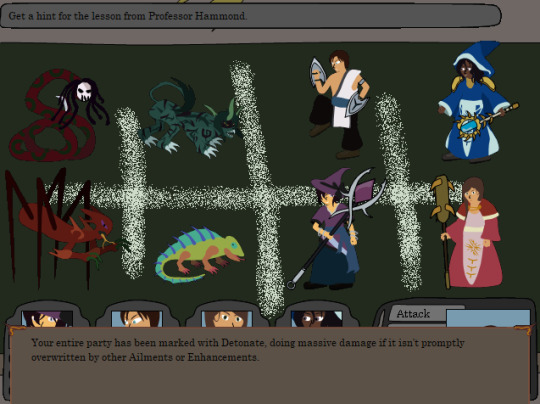
Just noticed I didn't include a download link yet, so let's just end this cleanly with that. Link to itch.io download here.
0 notes
Text
SEO Recap: PageRank
Have you ever wondered how Moz employees learn internally? Well, here’s your chance to get a sneak peek into never seen before, internal webinar footage with Tom Capper! Learning is important at Moz, and the sharing of information amongst employees is crucial in making sure we stay true to our core values. Knowledge sharing allows us to stay transparent, work together more easily, find better ways of doing things, and create even better tools and experiences for our customers.
Tom started these sessions when everyone was working remotely in 2020. It allowed us to come together again in a special, collaborative way. So, today, we give to you all the gift of learning! In this exclusive webinar, Tom Capper takes us through the crucial topic of PageRank.
Video Transcription
This is actually a topic that I used to put poor, innocent, new recruits through, particularly if they came from a non-marketing background. Even though this is considered by a lot people to be an advanced topic, I think it's something that actually it makes sense for people who want to learn about SEO to learn first because it's foundational. And if you think about a lot of other technical SEO and link building topics from this perspective, they make a lot more sense and are simpler and you kind of figure out the answers yourself rather than needing to read 10,000 word blog posts and patents and this kind of thing.
Anyway, hold that thought, because it's 1998. I am 6 years old, and this is a glorious state-of-the-art video game, and internet browsing that I do in my computer club at school looks a bit like this. I actually didn't use Yahoo!. I used Excite, which in hindsight was a mistake, but in my defense I was 6.
The one thing you'll notice about this as a starting point for a journey on the internet, compared to something like Google or whatever you use today, maybe even like something that's built into your browser these days, there is a lot of links on this page, and mostly there are links to pages with links on this page. It's kind of like a taxonomy directory system. And this is important because if a lot of people browse the web using links, and links are primarily a navigational thing, then we can get some insights out of looking at links.
They're a sort of proxy for popularity. If we assume that everyone starts their journey on the internet on Yahoo! in 1998, then the pages that are linked to from Yahoo! are going to get a lot of traffic. They are, by definition, popular, and the pages that those pages link to will also still get quite a lot and so on and so forth. And through this, we could build up some kind of picture of what websites are popular. And popularity is important because if you show popular websites to users in search results, then they will be more trustworthy and credible and likely to be good and this kind of thing.
This is massive oversimplification, bear with me, but this is kind of why Google won. Google recognized this fact, and they came up with an innovation called PageRank, which made their search engine better than other people's search engines, and which every other search engine subsequently went on to imitate.
However, is anything I said just now relevant 23 years later? We definitely do not primarily navigate the word with links anymore. We use these things called search engines, which Google might know something about. But also we use newsfeeds, which are kind of dynamic and uncrawlable, and all sorts of other non-static, HTML link-based patterns. Links are probably not the majority even of how we navigate our way around the web, except maybe within websites. And Google has better data on popularity anyway. Like Google runs a mobile operating system. They run ISPs. They run a browser. They run YouTube. There are lots of ways for Google to figure out what is and isn't popular without building some arcane link graph.
However, be that true or not, there still is a core methodology that underpins how Google works on a foundational level. In 1998, it was the case that PageRank was all of how Google worked really. It was just PageRank plus relevance. These days, there's a lot of nuance and layers on top, and even PageRank itself probably isn't even called that and probably has changed and been refined and tweaked around the edges. And it might be that PageRank is not used as a proxy for popularity anymore, but maybe as a proxy for trust or something like that and it has a slightly different role in the algorithm.
But the point is we still know purely through empirical evidence that changing how many and what pages link to a page has a big impact on organic performance. So we still know that something like this is happening. And the way that Google talks about how links work and their algorithms still reflects a broadly PageRank-based understanding as do developments in SEO directives and hreflang and rel and this kind of thing. It still all speaks to a PageRank-based ecosystem, if not a PageRank-only ecosystem.
Also, I'm calling it PageRank because that's what Google calls it, but some other things you should be aware of that SEOs use, link equity I think is a good one to use because it kind of explains what you're talking about in a useful way. Link flow, it's not bad, but link flow is alluding to a different metaphor that you've probably seen before, where you think of links as being sent through big pipes of liquids that then pour in different amounts into different pages. It's a different metaphor to the popularity one, and as a result it has some different implications if it's overstretched, so use some caution. And then linking strength, I don't really know what metaphor this is trying to do. It doesn't seem as bad as link juice, at least fine, I guess.
More importantly, how does it work? And I don't know if anyone here hates maths. If you do, I'm sorry, but there's going to be maths.
So the initial sort of question is or the foundation of all this is imagine that, so A, in the red box here, that's a web page to be clear in this diagram, imagine that the whole internet is represented in this diagram, that there's only one web page, which means this is 1970 something, I guess, what is the probability that a random browser is on this page? We can probably say it's one or something like that. If you want to have some other take on that, it kind of doesn't matter because it's all just going to be based on whatever number that is. From that though, we can sort of try to infer some other things.
So whatever probability you thought that was, and let's say we thought that if there's one page on the internet, everyone is on it, what's the probability a random browser is on the one page, A, links to? So say that we've pictured the whole internet here. A is a page that links to another page which links nowhere. And we started by saying that everyone was on this page. Well, what's the probability now, after a cycle, that everyone will be on this page? Well, we go with the assumption that there's an 85% chance, and the 85% number comes from Google's original 1998 white paper. There's an 85% chance that they go onto this one page in their cycle, and a 15% chance that they do one of these non-browser-based activities. And the reason why we assume that there's a chance on every cycle that people exit to do non-browser-based activities, it's because otherwise we get some kind of infinite cycle later on. We don't need to worry about that. But yeah, the point is that if you assume that people never leave their computers and that they just browse through links endlessly, then you end up assuming eventually that every page has infinite traffic, which is not the case.
That's the starting point where we have this really simple internet, we have a page with a link on it, and a page without a link on it and that's it. Something to bear in mind with these systems is, obviously, web pages don't have our link on them and web pages with no links on them are virtually unheard of, like the one on the right. This gets really complex really fast. If we try to make a diagram just of two pages on the Moz website, it would not fit on the screen. So we're talking with really simplified versions here, but it doesn't matter because the principles are extensible.
So what if the page on the left actually linked to two pages, not one? What is the probability now that we're on one of those two pages? We're taking that 85% chance that they move on at all without exiting, because the house caught fire, they went for a bike ride or whatever, and we're now dividing that by two. So we're saying 42.5% chance that they were on this page, 42.5% chance they were on this page, and then nothing else happens because there are no more links in the world. That's fine.
What about this page? So if this page now links to one more, how does this page's strength relates to page A? So this one was 0.85/2, and this one is 0.85 times that number. So note that we are diluting as we go along because we've applied that 15% deterioration on every step. This is useful and interesting to us because we can imagine a model in which page A, on the left, is our homepage and the page on the right is some page we want to rank, and we're diluting with every step that we have to jump to get there. And this is crawl depth, which is a metric that is exposed by Moz Pro and most other technical SEO tools. That's why crawl depth is something that people are interested in is this, and part of it is discovery, which we won't get into today, but part of it is also this dilution factor.
And then if this page actually linked to three, then again, each of these pages is only one-third as strong as when it only linked to one. So it's being split up and diluted the further down we go.
So that all got very complicated very quick on a very simple, fictional website. Don't panic. The lessons we want to take away from this are quite simple, even though the math becomes very arcane very quickly.
So the first lesson we want to take is that each additional link depth diluted value. So we talked about the reasons for that, but obviously it has implications for site structure. It also has implications in some other things, some other common technical SEO issues that I'll cover in a bit.
So if I link to a page indirectly that is less effective than linking to a page directly, even in a world where every page only has one link on it, which is obviously an ideal scenario.
The other takeaway we can have is that more links means each link is less valuable. So if every additional link you add to your homepage, you're reducing the effectiveness of the links that were already there. So this is very important because if you look on a lot of sites right now, you'll find 600 link mega navs at the top of the page and the same at the bottom of the page and all this kind of thing. And that can be an okay choice. I'm not saying that's always wrong, but it is a choice and it has dramatic implications.
Some of the biggest changes in SEO performance I've ever seen on websites came from cutting back the number of links on the homepage by a factor of 10. If you change a homepage so that it goes from linking to 600 pages to linking to the less than 100 that you actually want to rank, that will almost always have a massive difference, a massive impact, more so than external link building could ever dream of because you're not going to get that 10 times difference through external link building, unless it's a startup or something.
Some real-world scenarios. I want to talk about basically some things that SEO tools often flag, that we're all familiar with talking about as SEO issues or optimizations or whatever, but often we don't think about why and we definitely don't think of them as being things that hark back quite so deep into Google's history.
So a redirect is a link, the fictional idea of a page with one link on it is a redirect, because a redirect is just a page that links to exactly one other page. So in this scenario, the page on the left could have linked directly to the page on the top right, but because it didn't, we've got this 0.85 squared here, which is 0.7225. The only thing you need to know about that is that it's a smaller number than 0.85. Because we didn't link directly, we went through this page here that redirected, which doesn't feel like a link, but is a link in this ecosystem, we've just arbitrarily decided to dilute the page at the end of the cycle. And this is, obviously, particularly important when we think about chain redirects, which is another thing that's often flagged by the SEO tools.
But when you look in an issue report in something like Moz Pro and it gives you a list of redirects as if they're issues, that can be confusing because a redirect is something we're also told is a good thing. Like if we have a URL that's no longer in use, it should redirect. But the reason that issue is being flagged is we shouldn't still be linking to the URL that redirects. We should be linking directly to the thing at the end of the chain. And this is why. It's because of this arbitrary dilution that we're inserting into our own website, which is basically just a dead weight loss. If you imagine that in reality, pages do tend to link back to each other, this will be a big complex web and cycle that is, and I think this is where the flow thing comes around because people can imagine a flow of buckets that drip round into each other but leak a little bit at every step, and then you get less and less water, unless there's some external source. If you imagine these are looping back around, then inserting redirects is just dead weight loss. We've drilled a hole in the bottom of a bucket.
So, yeah, better is a direct link. Worse is a 302, although that's a controversial subject, who knows. Google sometimes claim that they treat 302s as 301s these days. Let's not get into that.
Canonicals, very similar, a canonical from a PageRank perspective. A canonical is actually a much later addition to search engines. But a canonical is basically equivalent to a 301 redirect. So if we have this badgers page, which has two versions, so you can access it by going to badgers?colour=brown. Or so imagine I have a website that sells live badgers for some reason in different colors, and then I might have these two different URL variants for my badger e-com page filtered to brown. And I've decided that this one without any parameters is the canonical version, literally and figuratively speaking. If the homepage links to it via this parameter page, which then has canonical tag pointing at the correct version, then I've arbitrarily weakened the correct version versus what I could have done, which would be the direct link through. Interestingly, if we do have this direct link through, note that this page now has no strength at all. It now has no inbound links, and also it probably wouldn't get flagged as an error in the tool because the tool wouldn't find it.
You'll notice I put a tilde before the number zero. We'll come to that.
PageRank sculpting is another thing that I think is interesting because people still try to do it even though it's not worked for a really long time. So this is an imaginary scenario that is not imaginary at all. It's really common, Moz probably has this exact scenario, where your homepage links to some pages you care about and also some pages you don't really care about, certainly from an SEO perspective, such as your privacy policy. Kind of sucks because, in this extreme example here, having a privacy policy has just randomly halved the strength of a page you care about. No one wants that.
So what people used to do was they would use a link level nofollow. They use a link level nofollow, which . . . So the idea was, and it worked at the time, and by at the time, I mean like 2002 or something. But people still try this on new websites today. The idea was that effectively the link level nofollow removed this link, so it was as if your homepage only linked to one page. Great, everyone is a winner.
Side note I talked about before. So no page actually has zero PageRank. A page with no links in the PageRank model has the PageRank one over the number of pages on the internet. That's the seeding probability that before everything starts going and cycles round and figures out what the stable equilibrium PageRank is, they assume that there's an equal chance you're on any page on the internet. One divided by the number of pages on the internet is a very small number, so we can think of it as zero.
This was changed, our level nofollow hack was changed again a very, very long time ago such that if you use a link level nofollow, and by the way, this is also true if you use robots.txt to do this, this second link will still be counted in when we go here and we have this divided by two to say we are halving, there's an equal chance that you go to either of these pages. This page still gets that reduction because it was one of two links, but this page at the bottom now has no strength at all because it was only linked through a nofollow. So if you do this now, it's a worst of both world scenario. And you might say, "Oh, I don't actually care whether my privacy policy has zero strength," whatever. But you do care because your privacy policy probably links through the top nav to every other page on your website. So you're still doing yourself a disservice.
Second side note, I said link level nofollow, meaning nofollow in the HTML is an attribute to a link. There is also page level nofollow, which I struggled to think of a single good use case for. Basically, a page level nofollow means we are going to treat every single link on this page as nofollow. So we're just going to create a PageRank dead-end. This is a strange thing to do. Sometimes people use robots.txt, which basically does the same thing. If I block this page with robota.txt, that's the same in terms of the PageRank consequences, except there are other good reasons to do that, like I might not want Google to ever see this, or I might want to prevent a massive waste of Google's crawlers' time so that they spend more time crawling the rest of my site or something like this. There are reasons to use robots.txt. Page level nofollow is we're going to create that dead-end, but also we're going to waste Google's time crawling it anyway.
Some of the extreme scenarios I just talked about, particularly the one with the privacy policy, changed a lot for the better for everyone in 2004 with something called reasonable surfer, which you occasionally still hear people talking about now, but mostly implicitly. And it is probably actually an under-discussed or underheld in mind topic.
So these days, and by these days, I mean for the last 17 years, if one of these links was that massive call to action and another one of these links was in the footer, like a privacy policy link often is, then Google will apply some sense and say the chance people click on this one . . . Google was trying to figure out probabilities here, remember. So we'll split this. This 0.9 and 0.1 still have to add up to 1, but we'll split them in a more reasonable fashion. Yeah, they were doing that a long time ago. They've probably got very, very good at it by now.
Noindex is an interesting one because, traditionally, you would think that has nothing to do with PageRank. So, yeah, a noindex tag just means this should never show up in search results, this page at the bottom, which is fine. There are some valid reasons to do that. Maybe you're worried that it will show up for the wrong query that something else on your site is trying to show up for, or maybe it contains sensitive information or something like this. Okay, fine. However, when you put a noindex tag on something, Google eventually stops crawling it. Everyone sort of intuitively knew all the pieces of this puzzle, but Google only acknowledged that this behavior is what happens a couple of years ago.
So Google eventually stops crawling it, and when Google stops crawling on it, it stops passing PageRank. So noindex follow, which used to be quite a good thing or we thought quite a good thing to do for a page like an HTML sitemap page or something like that, like an HTML sitemap page, clearly you don't want to show up in search results because it's kind of crap and a poor reflection on your site and not a good UX and this kind of thing. But it is a good way to pass equity through to a bunch of deep pages, or so we thought. It turns out probably not. It was equivalent to that worst case scenario, page level nofollow in the long run that we talked about earlier. And again, this is probably why noindex is flagged as an error in tools like Moz Pro, although often it's not well explained or understood.
My pet theory on how links work is that, at this stage, they're no longer a popularity proxy because there's better ways of doing that. But they are a brand proxy for a frequently cited brand. Citation and link are often used synonymously in this industry, so that kind of makes sense. However, once you actually start ranking in the top 5 or 10, my experience is that links become less and less relevant the more and more competitive a position you're in because Google has increasingly better data to figure out whether people want to click on you or not. This is some data from 2009, contrasting ranking correlations in positions 6 to 10, versus positions 1 to 5. Basically, both brand and link become less relevant, or the easily measured versions become less relevant, which again is kind of exploring that theory that the higher up you rank, the more bespoke and user signal-based it might become.
This is some older data, where I basically looked at to what extent you can use Domain Authority to predict rankings, which is this blue bar, to what extent you could use branded search volume to predict rankings, which is this green bar, and to what extent you could use a model containing them both to predict rankings, which is not really any better than just using branded search volume. This is obviously simplified and flawed data, but this is some evidence towards the hypothesis that links are used as a brand proxy.
Video transcription by Speechpad.com
0 notes
Text
SEO Recap: PageRank
Have you ever wondered how Moz employees learn internally? Well, here’s your chance to get a sneak peek into never seen before, internal webinar footage with Tom Capper! Learning is important at Moz, and the sharing of information amongst employees is crucial in making sure we stay true to our core values. Knowledge sharing allows us to stay transparent, work together more easily, find better ways of doing things, and create even better tools and experiences for our customers.
Tom started these sessions when everyone was working remotely in 2020. It allowed us to come together again in a special, collaborative way. So, today, we give to you all the gift of learning! In this exclusive webinar, Tom Capper takes us through the crucial topic of PageRank.
Video Transcription
This is actually a topic that I used to put poor, innocent, new recruits through, particularly if they came from a non-marketing background. Even though this is considered by a lot people to be an advanced topic, I think it's something that actually it makes sense for people who want to learn about SEO to learn first because it's foundational. And if you think about a lot of other technical SEO and link building topics from this perspective, they make a lot more sense and are simpler and you kind of figure out the answers yourself rather than needing to read 10,000 word blog posts and patents and this kind of thing.
Anyway, hold that thought, because it's 1998. I am 6 years old, and this is a glorious state-of-the-art video game, and internet browsing that I do in my computer club at school looks a bit like this. I actually didn't use Yahoo!. I used Excite, which in hindsight was a mistake, but in my defense I was 6.
The one thing you'll notice about this as a starting point for a journey on the internet, compared to something like Google or whatever you use today, maybe even like something that's built into your browser these days, there is a lot of links on this page, and mostly there are links to pages with links on this page. It's kind of like a taxonomy directory system. And this is important because if a lot of people browse the web using links, and links are primarily a navigational thing, then we can get some insights out of looking at links.
They're a sort of proxy for popularity. If we assume that everyone starts their journey on the internet on Yahoo! in 1998, then the pages that are linked to from Yahoo! are going to get a lot of traffic. They are, by definition, popular, and the pages that those pages link to will also still get quite a lot and so on and so forth. And through this, we could build up some kind of picture of what websites are popular. And popularity is important because if you show popular websites to users in search results, then they will be more trustworthy and credible and likely to be good and this kind of thing.
This is massive oversimplification, bear with me, but this is kind of why Google won. Google recognized this fact, and they came up with an innovation called PageRank, which made their search engine better than other people's search engines, and which every other search engine subsequently went on to imitate.
However, is anything I said just now relevant 23 years later? We definitely do not primarily navigate the word with links anymore. We use these things called search engines, which Google might know something about. But also we use newsfeeds, which are kind of dynamic and uncrawlable, and all sorts of other non-static, HTML link-based patterns. Links are probably not the majority even of how we navigate our way around the web, except maybe within websites. And Google has better data on popularity anyway. Like Google runs a mobile operating system. They run ISPs. They run a browser. They run YouTube. There are lots of ways for Google to figure out what is and isn't popular without building some arcane link graph.
However, be that true or not, there still is a core methodology that underpins how Google works on a foundational level. In 1998, it was the case that PageRank was all of how Google worked really. It was just PageRank plus relevance. These days, there's a lot of nuance and layers on top, and even PageRank itself probably isn't even called that and probably has changed and been refined and tweaked around the edges. And it might be that PageRank is not used as a proxy for popularity anymore, but maybe as a proxy for trust or something like that and it has a slightly different role in the algorithm.
But the point is we still know purely through empirical evidence that changing how many and what pages link to a page has a big impact on organic performance. So we still know that something like this is happening. And the way that Google talks about how links work and their algorithms still reflects a broadly PageRank-based understanding as do developments in SEO directives and hreflang and rel and this kind of thing. It still all speaks to a PageRank-based ecosystem, if not a PageRank-only ecosystem.
Also, I'm calling it PageRank because that's what Google calls it, but some other things you should be aware of that SEOs use, link equity I think is a good one to use because it kind of explains what you're talking about in a useful way. Link flow, it's not bad, but link flow is alluding to a different metaphor that you've probably seen before, where you think of links as being sent through big pipes of liquids that then pour in different amounts into different pages. It's a different metaphor to the popularity one, and as a result it has some different implications if it's overstretched, so use some caution. And then linking strength, I don't really know what metaphor this is trying to do. It doesn't seem as bad as link juice, at least fine, I guess.
More importantly, how does it work? And I don't know if anyone here hates maths. If you do, I'm sorry, but there's going to be maths.
So the initial sort of question is or the foundation of all this is imagine that, so A, in the red box here, that's a web page to be clear in this diagram, imagine that the whole internet is represented in this diagram, that there's only one web page, which means this is 1970 something, I guess, what is the probability that a random browser is on this page? We can probably say it's one or something like that. If you want to have some other take on that, it kind of doesn't matter because it's all just going to be based on whatever number that is. From that though, we can sort of try to infer some other things.
So whatever probability you thought that was, and let's say we thought that if there's one page on the internet, everyone is on it, what's the probability a random browser is on the one page, A, links to? So say that we've pictured the whole internet here. A is a page that links to another page which links nowhere. And we started by saying that everyone was on this page. Well, what's the probability now, after a cycle, that everyone will be on this page? Well, we go with the assumption that there's an 85% chance, and the 85% number comes from Google's original 1998 white paper. There's an 85% chance that they go onto this one page in their cycle, and a 15% chance that they do one of these non-browser-based activities. And the reason why we assume that there's a chance on every cycle that people exit to do non-browser-based activities, it's because otherwise we get some kind of infinite cycle later on. We don't need to worry about that. But yeah, the point is that if you assume that people never leave their computers and that they just browse through links endlessly, then you end up assuming eventually that every page has infinite traffic, which is not the case.
That's the starting point where we have this really simple internet, we have a page with a link on it, and a page without a link on it and that's it. Something to bear in mind with these systems is, obviously, web pages don't have our link on them and web pages with no links on them are virtually unheard of, like the one on the right. This gets really complex really fast. If we try to make a diagram just of two pages on the Moz website, it would not fit on the screen. So we're talking with really simplified versions here, but it doesn't matter because the principles are extensible.
So what if the page on the left actually linked to two pages, not one? What is the probability now that we're on one of those two pages? We're taking that 85% chance that they move on at all without exiting, because the house caught fire, they went for a bike ride or whatever, and we're now dividing that by two. So we're saying 42.5% chance that they were on this page, 42.5% chance they were on this page, and then nothing else happens because there are no more links in the world. That's fine.
What about this page? So if this page now links to one more, how does this page's strength relates to page A? So this one was 0.85/2, and this one is 0.85 times that number. So note that we are diluting as we go along because we've applied that 15% deterioration on every step. This is useful and interesting to us because we can imagine a model in which page A, on the left, is our homepage and the page on the right is some page we want to rank, and we're diluting with every step that we have to jump to get there. And this is crawl depth, which is a metric that is exposed by Moz Pro and most other technical SEO tools. That's why crawl depth is something that people are interested in is this, and part of it is discovery, which we won't get into today, but part of it is also this dilution factor.
And then if this page actually linked to three, then again, each of these pages is only one-third as strong as when it only linked to one. So it's being split up and diluted the further down we go.
So that all got very complicated very quick on a very simple, fictional website. Don't panic. The lessons we want to take away from this are quite simple, even though the math becomes very arcane very quickly.
So the first lesson we want to take is that each additional link depth diluted value. So we talked about the reasons for that, but obviously it has implications for site structure. It also has implications in some other things, some other common technical SEO issues that I'll cover in a bit.
So if I link to a page indirectly that is less effective than linking to a page directly, even in a world where every page only has one link on it, which is obviously an ideal scenario.
The other takeaway we can have is that more links means each link is less valuable. So if every additional link you add to your homepage, you're reducing the effectiveness of the links that were already there. So this is very important because if you look on a lot of sites right now, you'll find 600 link mega navs at the top of the page and the same at the bottom of the page and all this kind of thing. And that can be an okay choice. I'm not saying that's always wrong, but it is a choice and it has dramatic implications.
Some of the biggest changes in SEO performance I've ever seen on websites came from cutting back the number of links on the homepage by a factor of 10. If you change a homepage so that it goes from linking to 600 pages to linking to the less than 100 that you actually want to rank, that will almost always have a massive difference, a massive impact, more so than external link building could ever dream of because you're not going to get that 10 times difference through external link building, unless it's a startup or something.
Some real-world scenarios. I want to talk about basically some things that SEO tools often flag, that we're all familiar with talking about as SEO issues or optimizations or whatever, but often we don't think about why and we definitely don't think of them as being things that hark back quite so deep into Google's history.
So a redirect is a link, the fictional idea of a page with one link on it is a redirect, because a redirect is just a page that links to exactly one other page. So in this scenario, the page on the left could have linked directly to the page on the top right, but because it didn't, we've got this 0.85 squared here, which is 0.7225. The only thing you need to know about that is that it's a smaller number than 0.85. Because we didn't link directly, we went through this page here that redirected, which doesn't feel like a link, but is a link in this ecosystem, we've just arbitrarily decided to dilute the page at the end of the cycle. And this is, obviously, particularly important when we think about chain redirects, which is another thing that's often flagged by the SEO tools.
But when you look in an issue report in something like Moz Pro and it gives you a list of redirects as if they're issues, that can be confusing because a redirect is something we're also told is a good thing. Like if we have a URL that's no longer in use, it should redirect. But the reason that issue is being flagged is we shouldn't still be linking to the URL that redirects. We should be linking directly to the thing at the end of the chain. And this is why. It's because of this arbitrary dilution that we're inserting into our own website, which is basically just a dead weight loss. If you imagine that in reality, pages do tend to link back to each other, this will be a big complex web and cycle that is, and I think this is where the flow thing comes around because people can imagine a flow of buckets that drip round into each other but leak a little bit at every step, and then you get less and less water, unless there's some external source. If you imagine these are looping back around, then inserting redirects is just dead weight loss. We've drilled a hole in the bottom of a bucket.
So, yeah, better is a direct link. Worse is a 302, although that's a controversial subject, who knows. Google sometimes claim that they treat 302s as 301s these days. Let's not get into that.
Canonicals, very similar, a canonical from a PageRank perspective. A canonical is actually a much later addition to search engines. But a canonical is basically equivalent to a 301 redirect. So if we have this badgers page, which has two versions, so you can access it by going to badgers?colour=brown. Or so imagine I have a website that sells live badgers for some reason in different colors, and then I might have these two different URL variants for my badger e-com page filtered to brown. And I've decided that this one without any parameters is the canonical version, literally and figuratively speaking. If the homepage links to it via this parameter page, which then has canonical tag pointing at the correct version, then I've arbitrarily weakened the correct version versus what I could have done, which would be the direct link through. Interestingly, if we do have this direct link through, note that this page now has no strength at all. It now has no inbound links, and also it probably wouldn't get flagged as an error in the tool because the tool wouldn't find it.
You'll notice I put a tilde before the number zero. We'll come to that.
PageRank sculpting is another thing that I think is interesting because people still try to do it even though it's not worked for a really long time. So this is an imaginary scenario that is not imaginary at all. It's really common, Moz probably has this exact scenario, where your homepage links to some pages you care about and also some pages you don't really care about, certainly from an SEO perspective, such as your privacy policy. Kind of sucks because, in this extreme example here, having a privacy policy has just randomly halved the strength of a page you care about. No one wants that.
So what people used to do was they would use a link level nofollow. They use a link level nofollow, which . . . So the idea was, and it worked at the time, and by at the time, I mean like 2002 or something. But people still try this on new websites today. The idea was that effectively the link level nofollow removed this link, so it was as if your homepage only linked to one page. Great, everyone is a winner.
Side note I talked about before. So no page actually has zero PageRank. A page with no links in the PageRank model has the PageRank one over the number of pages on the internet. That's the seeding probability that before everything starts going and cycles round and figures out what the stable equilibrium PageRank is, they assume that there's an equal chance you're on any page on the internet. One divided by the number of pages on the internet is a very small number, so we can think of it as zero.
This was changed, our level nofollow hack was changed again a very, very long time ago such that if you use a link level nofollow, and by the way, this is also true if you use robots.txt to do this, this second link will still be counted in when we go here and we have this divided by two to say we are halving, there's an equal chance that you go to either of these pages. This page still gets that reduction because it was one of two links, but this page at the bottom now has no strength at all because it was only linked through a nofollow. So if you do this now, it's a worst of both world scenario. And you might say, "Oh, I don't actually care whether my privacy policy has zero strength," whatever. But you do care because your privacy policy probably links through the top nav to every other page on your website. So you're still doing yourself a disservice.
Second side note, I said link level nofollow, meaning nofollow in the HTML is an attribute to a link. There is also page level nofollow, which I struggled to think of a single good use case for. Basically, a page level nofollow means we are going to treat every single link on this page as nofollow. So we're just going to create a PageRank dead-end. This is a strange thing to do. Sometimes people use robots.txt, which basically does the same thing. If I block this page with robota.txt, that's the same in terms of the PageRank consequences, except there are other good reasons to do that, like I might not want Google to ever see this, or I might want to prevent a massive waste of Google's crawlers' time so that they spend more time crawling the rest of my site or something like this. There are reasons to use robots.txt. Page level nofollow is we're going to create that dead-end, but also we're going to waste Google's time crawling it anyway.
Some of the extreme scenarios I just talked about, particularly the one with the privacy policy, changed a lot for the better for everyone in 2004 with something called reasonable surfer, which you occasionally still hear people talking about now, but mostly implicitly. And it is probably actually an under-discussed or underheld in mind topic.
So these days, and by these days, I mean for the last 17 years, if one of these links was that massive call to action and another one of these links was in the footer, like a privacy policy link often is, then Google will apply some sense and say the chance people click on this one . . . Google was trying to figure out probabilities here, remember. So we'll split this. This 0.9 and 0.1 still have to add up to 1, but we'll split them in a more reasonable fashion. Yeah, they were doing that a long time ago. They've probably got very, very good at it by now.
Noindex is an interesting one because, traditionally, you would think that has nothing to do with PageRank. So, yeah, a noindex tag just means this should never show up in search results, this page at the bottom, which is fine. There are some valid reasons to do that. Maybe you're worried that it will show up for the wrong query that something else on your site is trying to show up for, or maybe it contains sensitive information or something like this. Okay, fine. However, when you put a noindex tag on something, Google eventually stops crawling it. Everyone sort of intuitively knew all the pieces of this puzzle, but Google only acknowledged that this behavior is what happens a couple of years ago.
So Google eventually stops crawling it, and when Google stops crawling on it, it stops passing PageRank. So noindex follow, which used to be quite a good thing or we thought quite a good thing to do for a page like an HTML sitemap page or something like that, like an HTML sitemap page, clearly you don't want to show up in search results because it's kind of crap and a poor reflection on your site and not a good UX and this kind of thing. But it is a good way to pass equity through to a bunch of deep pages, or so we thought. It turns out probably not. It was equivalent to that worst case scenario, page level nofollow in the long run that we talked about earlier. And again, this is probably why noindex is flagged as an error in tools like Moz Pro, although often it's not well explained or understood.
My pet theory on how links work is that, at this stage, they're no longer a popularity proxy because there's better ways of doing that. But they are a brand proxy for a frequently cited brand. Citation and link are often used synonymously in this industry, so that kind of makes sense. However, once you actually start ranking in the top 5 or 10, my experience is that links become less and less relevant the more and more competitive a position you're in because Google has increasingly better data to figure out whether people want to click on you or not. This is some data from 2009, contrasting ranking correlations in positions 6 to 10, versus positions 1 to 5. Basically, both brand and link become less relevant, or the easily measured versions become less relevant, which again is kind of exploring that theory that the higher up you rank, the more bespoke and user signal-based it might become.
This is some older data, where I basically looked at to what extent you can use Domain Authority to predict rankings, which is this blue bar, to what extent you could use branded search volume to predict rankings, which is this green bar, and to what extent you could use a model containing them both to predict rankings, which is not really any better than just using branded search volume. This is obviously simplified and flawed data, but this is some evidence towards the hypothesis that links are used as a brand proxy.
Video transcription by Speechpad.com
0 notes
Note
This about your walkable cities post -> I’m reading a conflation between ecologically conscious and pedestrian friendly in your post. I don’t think that mindset is shared by a majority of walkable city initiatives. From my experience, walkable city movements are aimed at reducing alienation in area currently actively hostile to anyone not in a car. Someone might advocate for a series of traffic lights and crosswalks on a multi-lane road as part of a walkable city initiative; an ecologically conscious person could oppose this plan due to an increase in idling. That’s an example to illustrate my point that they are separate problems with sometimes overlapping solutions. A planned city designed to be walkable might have a lower carbon footprint but the focus is on reducing pedestrian fatality (through things like extended sidewalks, red light timers, and sight lines, benefiting wheelchair users, children, distracted walking pedestrians and literally everyone) is by nature inclusive for people who use mobility aids. I can fully see how a city designed to be ecologically conscious would/could/HAS failed people with mobility disabilities. Pedestrian friendly =/= car hostile. If there’s a crux of this issue I’m not getting I’d very much appreciate a response about it I’m not trying to shove my fingers in my ears but your post and the emphasis on eco seemed like it was based on a misunderstanding. To me
"I can fully see how a city designed to be ecologically conscious would/could/HAS failed people with mobility disabilities." then you know why I'm angry. I am not against walkable cities or pedestrian rights. I am very supportive actually. I drive through an area with one of the WORST walkability scores. Every road has dozens of small memorials for people who died while trying to cross the street or even just from being on the sidewalk. It's horrible. I'm sorry if my post came across as "Pedestrian friendly == car hostile". I tried to be clear with my pro-pedestrian stance but my brain fog sometimes gets in the way.
I'm not trying to debate on if pedestrian-friendly cities are bad or not. I was mostly venting about that one post I saw (which I won't link cause I don't want people going after that person). Like, I'm pissed cause they dismissed disabled peoples voices in the conversation as a psy op and I hate that that term is being misused and people might dismiss disabled voices as a psy op because of it. I hate that people are coming into the replies of that post saying "I have intimate experience with sustainability and you obviously don't so I'm going to explain what the walkable cities initiative means" I know what it means! I support it! But I will continue to speak up when people part of that movement forget about disabled people! and if someone called me a psy op I would bite their head off! And yes there is a problem with calling it walkable. It's not destroying the movement by pointing that out. What's wrong with calling it pedestrian friendly? What is wrong with people simply pointing out the problems with that word?
Some people take walkable to mean pedestrian focused and car hostile! Some people think that means no roads and only bikes! And a lot of European cities are designed around that idea (see the notes for examples). They tout being walkable and sustainable and in reality are HORRIBLE for disabled people to get around! And even if everyone did understand that walkable meant "not pedestrian hostile" and inherently included public transportation, they still would need to hear disabled voices to make sure that those cities are actually accessible! And before you say I'm making up a guy to be mad at, I'VE TALKED TO THESE PEOPLE! THEY ARE IN MY SUSTAINABILITY CLASSES! THEY ARE THE ONES IN CHARGE OF HOW OUR BUSES RUN AND HOW OUR CITY IS PLANNED! Honestly I've been surprised at how many people have had that "huh" moment where simply hearing about my experiences as a wheelchair user have made them realize how they literally never considered what challenges someone like me faces.
And maybe you've never talked to someone like that. Maybe everyone in your city is super focused on accessibility. Maybe all the papers you've read include disabled voices. Maybe most of them do. And I would be happy for you! I would be so freaking happy that there are so many of those papers and articles and down-to-earth people! I'd ask that you share those with me!
But I am sharing my experience. and if you look in the notes, many people have shared this and similar experiences. Just cause you haven't seen these problems doesn't mean they don't exist! And so many people reply to my posts angry that I point out these problems! Its so weird! And also kinda fucked up!
And also calling these problems a psy op is also fucked up!
#asks#I'm not accusing you of all of these by the way anon#I have no way of knowing if you are one of those people in the replies#im just frustrated that that post is being derailed and twisted#I dont have a lot of followers and wasnt expecting it to become so popular so quick#If I did I wouldve spent more time making sure it was clearer and like an actual essay and not just a tumblr post#Not that I dont try to be clear but I usually dont have other people read it over first
0 notes
Text
Proven Easy Link Building Strategies 2022 - Will They Work?

Link building strategies are now an effective way to gain authority backlinks and increase organic traffic to our site, hence increasing the website’s rankings in Google SERPs.
But some of the SEO professionals, although, have exploited this unique opportunity that the internet has offered us by engaging in deceptive link procurement practices, which in effect hurts their rankings; you don’t have to be like them.
Today, I am going to explain some awesome link building strategies which helped me to increase my new website’s organic traffic tremendously. Below are those:
Guest Posting:
The benefits we can get from guest posting will be a lot. Research the websites or blogs that offer guest posts and reach out to them to contribute a guest post. There are a handful of blogs that welcome guest blog posts so start to get in touch with them to request a guest post.
This is one of the most successful ways of getting quality backlinks to our website and also gaining a new audience for our blog posts. Contributing guest posts is by no means a new technique but works well if done perfectly.
In addition to the SEO boost, massive traffic, brand awareness, and networking with key industry influencers can be achieved. All that you have to do is to create and contribute content regularly.
Broken Link Building
This broken link-building strategy concept is very simple and can also be highly efficient in link building strategies to rank. What’s more, it’s ethical, and for everyone involved, it’s a huge win. The person you’re contacting can modify a broken link, and you will get a backlink in return.
First, use a tool like Broken Link Checker to inspect for broken links of any website you want. Think about any websites you want to connect to and then just check for broken links.
Upon finding a list of links, check if you have certain information or articles on your website that might be linked to perhaps. The next step is to contact the blogger and let them be informed about the broken link and your suggestion for a replacement.
It’s a very simple method that can help enormously! But it is also time-consuming, just like most link building strategies.
Resource Page Link Building
This strategy is one of the most effective link building strategies for creating links; the goal is to get the reference (link) on the resource pages. What makes the building of resource site links so interesting is that they are easy to identify with a simple search on Google, and their authors are always seeking amazing new content.
Indeed, this is the intent of the resource page link building. Search engines also consider resource pages as good link sources – that ensures they could have a major impact on your ranking.
A resource page aims to curate the best content in a particular niche out there. So make sure your content is high quality and informative and falls into one of the categories presented before you start reaching out to get your content on someone’s resource list.
Pitching the resource page normally has a lower success rate since you’re requesting people to do things like a waste of time.
Inviting Guest Bloggers
If the method of the guest post is considered common, this is not the case. In practical terms, it is quite interesting that these link building strategies have not been explored by too many people. Rather than writing guest posts on other sites, what this strategy means is turning the system by asking famous bloggers to write guest posts on your website.
When you want to expand your website to other bloggers, setting up some guidelines is a great idea so you can prevent contributions of poor quality. It may be a bit more difficult to create and maintain guidelines that attract excellent contributions if it’s your first time actually with guest bloggers.
You will need to first demonstrate the requirements and objectives of your blog to create these guidelines. From there, it’s up to your future guest bloggers to read and follow these guidelines. On my blogs, I have mastered this technique, and my techniques are based on practical knowledge!
Link Reclamation:
Link reclamation is an essential component of an effective SEO link building strategy, but if you don’t know what it is, or why it is useful, it may seem annoying. Building backlinks is not a simple process, so it can be frustrating when your high-earned backlinks disappear entirely or when you find a broken backlink, it’s negatively affecting your SEO efforts, and damaging the whole credibility of your website.
Reclaiming lost backlinks is a bit more complicated task because we have no control over external links and it is up to other website owners. We can use paid tools like Ahrefs or Majestic to find the broken backlinks of our website or can use free backlink checker tools like SEO Review tools.After you have your broken backlink list, contact the website owners to provide them with the appropriate links to your website. Most likely, they will understand and appreciate your efforts and will be happy to update their page with the correct URL. This way, reclaiming backlinks is a great opportunity to strengthen SEO. It is a great way to get high quality backlinks for free.
Competitor Backlink Research
SEO’s main important component is to get inbound links from other sites to your website, preferably do-follow links. You can procure backlinks from the websites related to your niche, but it’s more effective to figure out who’s linking to your competitors first.
Search with your targeted keyword in Google to see who is ranking at the top in your niche. Shortlist the top five competitors. Generally, I will use Neil Patel’s Backlink Checker tool to know the competitor’s backlinks.
Simply enter one of your competitor backlinks in the tool and select whether to look for domain-level backlinks or page-level backlinks and hit the search button. You will get a list of competitor backlinks and from there you have to use filters to look for Dofollow links.
The results are pages that link to your competitor. Start analyzing links one by one, research which type of backlink it is, and follow the procedure to earn backlinks for your website too!
I’ve just written here on how to earn backlinks in 2022.
This is a living list, though. I need to hear from you now; what do you think of my latest linking building techniques in 2022?
This Article is Originally Posted on HiTechBuzz
0 notes